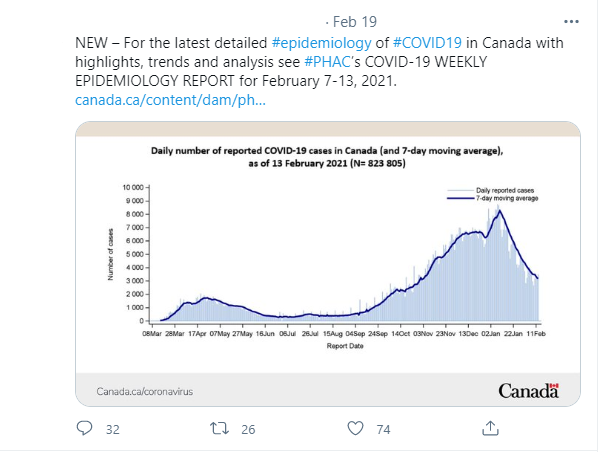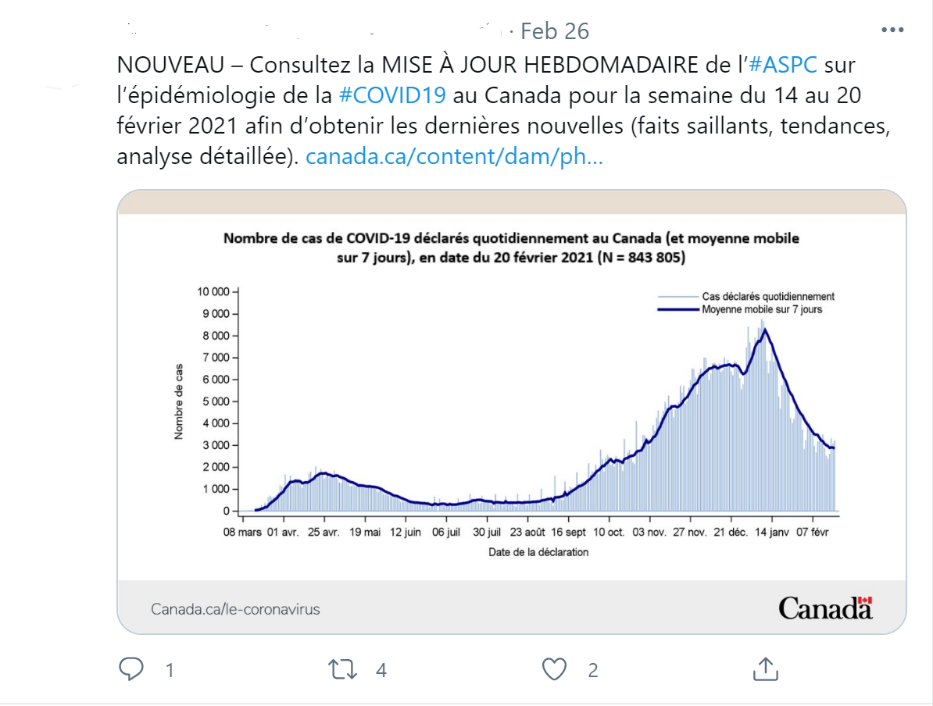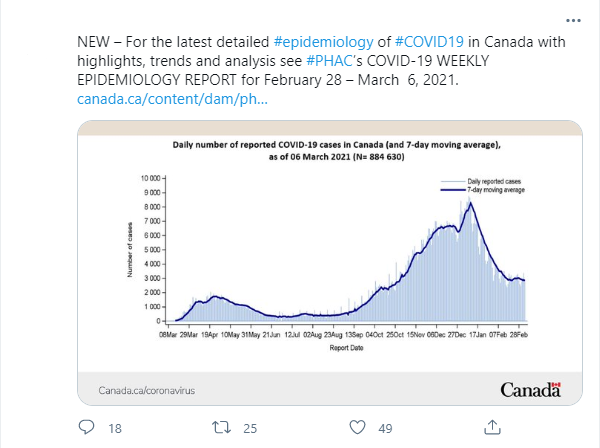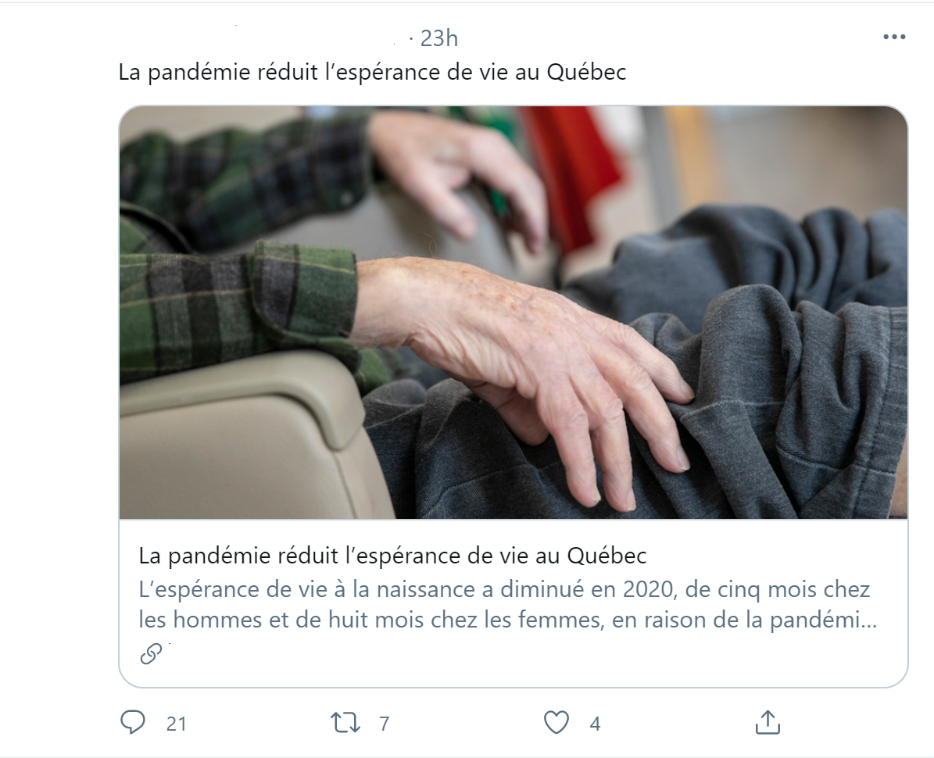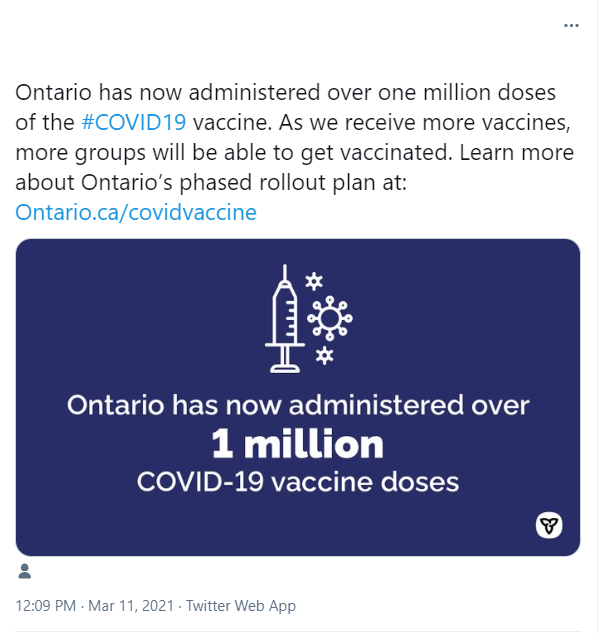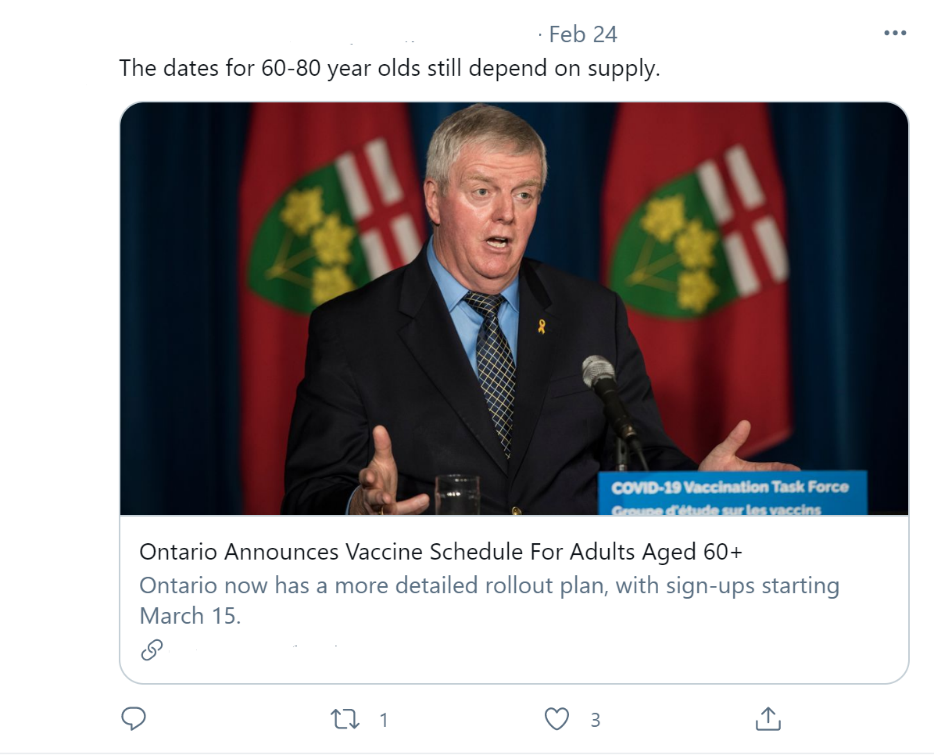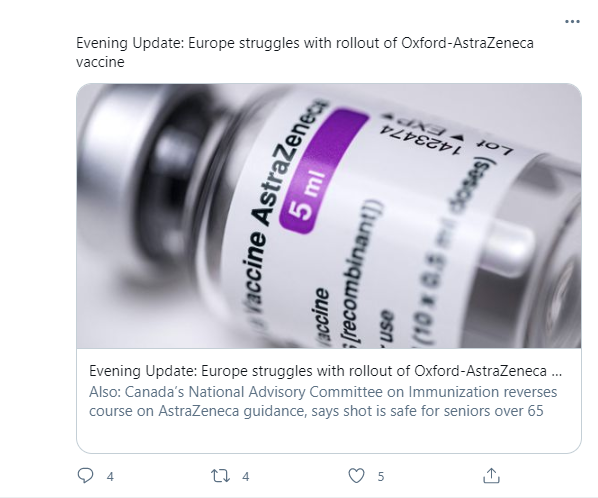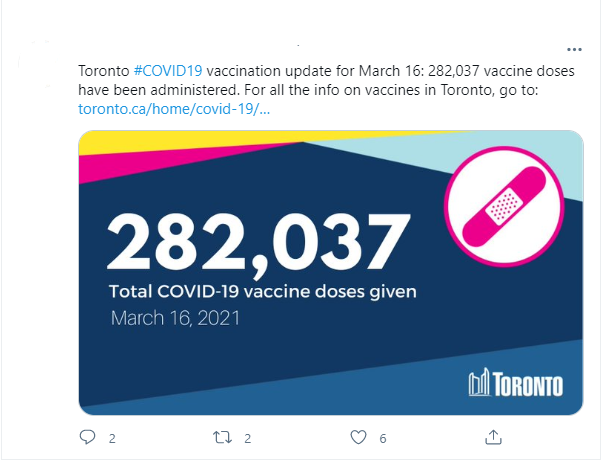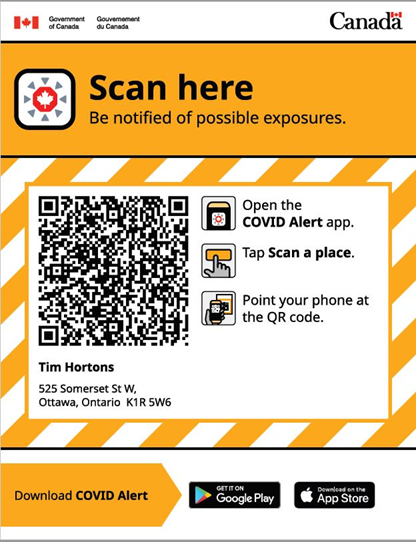MODERATOR’S GUIDE – March 2021
MASTER
INTRODUCTION (10 minutes) All Locations
- Moderator or technician should let participants know that they will need pen and paper in order to take some notes, jot down some thoughts around some material that we will show them later in the discussion.
GOVERNMENT OF CANADA IN THE NEWS (5-15 minutes) All Locations
- What have you seen, read or heard about the Government of Canada in the last few days?
- Mid-size and Major Centres Alberta Opinion Leaders Have you seen, read or heard anything about the Supreme Court of Canada ruling about carbon pricing over the last week? What have you heard?
Mid-size and Major Centres Alberta Opinion Leaders SHOW ON SCREEN:
Last week, the Supreme Court of Canada ruled that the federal government’s law requiring provinces and territories to implement carbon gas pricing systems by January 1, 2019, or adopt one imposed by the federal government, is constitutional. The majority of the judges noted that global warming causes harm beyond provincial boundaries and that it is a matter of national concern under the “peace, order and good government” clause of the Constitution. They also noted this law would only apply where provincial or territorial pricing systems are not strict enough to reduce global warming.
Mid-size and Major Centres Alberta Opinion Leaders Currently, the provincial systems in place in Ontario, Manitoba, Saskatchewan and Alberta do not fully meet federal benchmark stringency requirements; thus, the Government of Canada applies a price on pollution in these provinces.
- Mid-size and Major Centres Alberta Opinion Leaders What are your thoughts about this Supreme Court decision?
- Mid-size and Major Centres Alberta Opinion Leaders How do you feel about the carbon pricing system in Alberta?
- Mid-size and Major Centres Alberta Opinion Leaders Are you aware that approximately 90% of direct proceeds from the Government of Canada’s pollution pricing are returned to residents of those provinces through Climate Action Incentive payments?
- How do you feel about this?
Mid-size and Major Centres Alberta Opinion Leaders ADDITIONAL BACKGROUND INFORMATION TO MODERATOR (to clarify if there are any misunderstandings about the incentive payments)
The Government of Canada does not keep any direct proceeds from pollution pricing. All direct proceeds are returned to the province or territory of origin. The incentive payment to residents is delivered through personal income tax returns. The remaining 10% (i.e. the portion not returned to residents) is used to support small businesses, schools, universities, municipalities, and Indigenous groups.
COVID-19 VACCINE (15-20 minutes) Lower Mainland B.C. Vaccine Hesitant, Mid-size and Major Centres Quebec Vaccine Hesitant, Atlantic Canada, GTA Experiencing COVID Fatigue and Riskier Behaviours, GMA Young Adults
Lower Mainland B.C. Vaccine Hesitant, Mid-size and Major Centres Quebec Vaccine Hesitant Now I’d like to focus on COVID-19 vaccines…
Lower Mainland B.C. Vaccine Hesitant, Mid-size and Major Centres Quebec Vaccine Hesitant When we asked you to participate in this focus group, we asked whether you thought you would get vaccinated or not. Some of you said you would, but you preferred to wait, and others of you said you were unsure. Is this still the case? Why/why not?
-
- (FOR THOSE WHO ARE HESITANT) What are the factors that will influence your decision on whether or not to get vaccinated?
- Lower Mainland B.C. Vaccine Hesitant, Mid-size and Major Centres Quebec Vaccine Hesitant What question about COVID-19 vaccines would you most like an answer to?
And now thinking more broadly about the Government of Canada …
- Atlantic Canada, GTA Experiencing COVID Fatigue and Riskier Behaviours, GMA Young Adults What have you seen, read or heard about the COVID-19 vaccines recently?
- Do you think the Government of Canada is doing a good job in procuring and distributing the vaccine to provinces and territories, or not?
- Compared to other countries, how is Canada as a whole doing in terms of getting people vaccinated?
- Lower Mainland B.C. Vaccine Hesitant, Mid-size and Major Centres Quebec Vaccine Hesitant Canada is planning to vaccinate 3 million Canadians by the end of March and everyone who wants a vaccine by the end of September. How many of you were aware of this target?
- Do you think this is a reasonable target?
- Do you think Canada will hit this target? What makes you say that?
- Lower Mainland B.C. Vaccine Hesitant, Mid-size and Major Centres Quebec Vaccine Hesitant When do you think you personally will be in a position to receive a vaccine?
COVID-19 INFORMATION PREFERENCES (20 minutes) Lower Mainland B.C. Vaccine Hesitant, Major Centres Ontario Opinion Leaders, Mid-size and Major Centres Quebec Vaccine Hesitant, GTA Experiencing COVID Fatigue and Riskier Behaviours
Now I’d like to switch gears a bit to get a sense of the kind of information that gets your attention…
I’m going to show you some sample social media posts. I’m going to show them one at a time so that you can see each one clearly. I’ll show you 6 posts in total and then after that I’ll get your thoughts…
SHOW POSTS ON SCREEN ONE AT A TIME TO ALLOW A CHANCE TO SEE CLEARLY
Now that you’ve had a chance to see these, I’m going to put smaller versions on the screen so that you can see them all together
SHOW POSTS All TOGETHER
- If you saw these on social media, do think you would “like” or “share” any of them? Which ones? Why/why not?
- Are there any you would click on to find out more? Which ones? What makes you say that?
- IF THERE ARE ANY THAT NO ONE WOULD LIKE/SHARE/CLICK ON: Why is this post not appealing to you?
- PROMPT AS NEEDED: Is it the type of information presented? The way it’s presented? Its tone? (e.g. too negative/too positive) Something else?
POST-COVID-19 TRAVEL (25 minutes) Lower Mainland B.C. Vaccine Hesitant, Major Centres Ontario Opinion Leaders, Mid-size and Major Centres Quebec Vaccine Hesitant, Quebec Anglophones, Manitoba and Saskatchewan EI/Recovery Benefits Recipients, Toronto-Peel-York Region Hard Hit Sectors
In this next section, I’d like to talk about travel and vacation planning…
- Has anyone cancelled vacation plans over the past year because of COVID-19?
- Now thinking ahead to when the pandemic is over, do you plan on taking a vacation?
- Do you plan on spending more money, less or about the same amount of money than you usually do on vacation?
- Do you plan on travelling within Canada, or internationally?
- Is this different from your usual vacation plans?
- For any who plan to travel outside of Canada instead of their usual domestic trip: what made you decide to change it up?
- For any who plan to travel within Canada instead of their usual international trip: what made you decide to change it up?
I’m going to show you a list of things the Government of Canada could do to encourage Canadians to travel post-COVID within Canada as a way to support the Canadian tourism sector which has been hard hit by COVID-19.
SHOW ON SCREEN
-
- A credit where the third night of any hotel stay in Canada is free
- A promotion where you could fly anywhere in Canada at a cost of $200 per trip
- A refund of up to $200 on travel, hotels, or activities you could claim when you purchase them using an app
- A tax credit of $200 if you spend that same amount on travel within Canada
- Provide free travel passes for kids on train or airplane trips within Canada
- Provide free admissions to museums to all Canadians
- Provide free admissions to Parks Canada for all Canadians
- Would any of these convince you to take an extra trip in Canada or convince you to travel domestically instead of internationally? (PROBE ON WHICH ONES AND DISCUSS)
- What else could the Government of Canada do to encourage people to travel within Canada?
DIGITAL GOVERNMENT (35 minutes) Lower Mainland B.C. Vaccine Hesitant, Major Centres Ontario Opinion Leaders, Mid-size and Major Centres Quebec Vaccine Hesitant, Quebec Anglophones, Manitoba and Saskatchewan EI/Recovery Benefits Recipients, Toronto-Peel-York Region Hard Hit Sectors
Moving away from COVID-19, I want to talk about Government of Canada services...
- When you think about Government of Canada services, what types of services come to mind, whether you are interacting with the government in person, online or by telephone?
- Have you used any online Government of Canada services in the past year?
- Which ones?
- How was your experience with them?
- Specifically thinking outside the COVID-19 context, do you think the Government of Canada needs to make more services available online?
- Why/why not?
- IF YES: What types of services would you like to see online? (IF NECESSARY PROMPT: For example, services that are currently available online includes things like applying for benefits such as EI, affordability calculators to estimate how much rent or mortgage you can afford, and viewing the application status for immigration or citizenship applications, and so on.)
- What are some of the benefits of making more services available online?
I’m going to show you a list of reasons others have given for making more services available online...
SHOW ON SCREEN
-
- Having modern digital systems makes it a lot easier for governments to quickly implement big policy changes. For example, it was easier to roll the CERB out quickly because of the digital application and distribution system in place.
- It makes the lives of Canadians easier, because they can complete applications anywhere, anytime, and don’t have to spend time in lineups or on hold.
- Providing more online services to businesses makes Canada more competitive economically because it helps set up businesses and allows them to access the supports they need.
- Did any of these benefits catch your attention as a valuable benefit? Which one(s)? Why?
SHOW ON SCREEN AND THEN POLL: Now, I’m going to show you some objectives that could be used to develop the Government of Canada’s overall digital strategy. Then, we will do a poll to see which one you think they should be working towards (SELECT ONE)
-
- Delivering digital services that are secure, reliable and easy to use, from any device.
- Secure, reliable and easy to use, digital services that are built to serve Canadians.
- Secure, reliable and easy to use, transforming how we serve you.
- Secure, reliable and easy to use; services that work for you.
- Transforming your Government of Canada to serve you anytime, anywhere.
- Which one did you select? Why did you select that one?
- A lot of these statements use words like “secure”, “reliable”, and “easy to use”. Which of these 3 words is most important?
- Do you think “secure”, “reliable” and “easy to use” are the most important aspects of digital service delivery, or do you think there are other aspects that are as, or more important than, these 3?
- If the Government of Canada were to provide more services online, would you have confidence that they could make this switch so that services are more secure, reliable and easy to use? Why/why not?
- Does the Government of Canada’s ability to deliver services online impact your level of trust in the government overall?
COVID-19 INFORMATION / IN THE NEWS (15-20 minutes) Major Centres Ontario Opinion Leaders, Mid-size and Major Centres Alberta Opinion Leaders
- When we asked you to participate in this focus group, you said regularly watch, read or listen to the news. I was wondering if you could tell me where you get most of your news or information?
Now I’d like to focus on COVID-19…
- What kind of news or information about COVID-19 do you typically read?
- Do you seek specific information about COVID-19?
- When you find certain information or news articles, do you share it on your social media networks?
- Do you ever come across any false information (“fake news”)?
- How do you know when the information is false?
- Do you ever try to correct false information when you see it on social media?
- Do you correct false information coming from friends or family?
FRENCH LANGUAGE (15 minutes) Quebec Anglophones
- Have you read or heard anything about the Government of Canada’s recent proposed amendments to the Official Languages Act?
Last month, the Government of Canada proposed certain amendments to modernize the Official Languages Act. There are various amendments, and I’d like to highlight 5...
SHOW ON SCREEN:
- Increase French immersion programs outside Quebec: Demand for access to French immersion programs has exceeded supply in recent years.
- Increase Francophone immigration: Recruit Francophone and French-language teachers – for immersion teaching of second language programs, and for French-language education – to address the shortage of French language teachers in Canada, particularly outside of Quebec.
- Strengthen the role of Radio-Canada in protecting and promoting the French language.
- Appoint only bilingual Supreme Court justices to provide for the right to be understood directly by the judge, without the assistance of an interpreter, before all the courts.
- Strengthen the powers of the Commissioner of Official Languages: To be able to better enforce compliance with the Act, use alternative dispute resolution methods, and add grounds on which the Commissioner may refuse or cease to investigate a complaint.
- What are your initial thoughts about these amendments? Are these measures good?
- Will they have an impact on the French language in Canada?
Do you have a concern with any of them? If so, which ones? Why?
ECONOMIC GROWTH (20-40 minutes) Quebec Anglophones, Manitoba and Saskatchewan EI/Recovery Benefits Recipients, Toronto-Peel-York Region Hard Hit Sectors, Atlantic Canada, GTA Experiencing COVID Fatigue and Riskier Behaviours, Victoria and Nanaimo B.C., GMA Young Adults, Mid-size and Major Centres Alberta Opinion Leaders
Quebec Anglophones, Manitoba and Saskatchewan EI/Recovery Benefits Recipients, Toronto-Peel-York Region Hard Hit Sectors I’d like to talk to you about Canada’s economy…
- When you hear the term “economic growth”, what does that mean to you?
- If the Government of Canada said its next budget would be focused on economic growth, what kinds of things would you expect to see included in the budget?
- Quebec Anglophones, Manitoba and Saskatchewan EI/Recovery Benefits Recipients, Toronto-Peel-York Region Hard Hit Sectors When you think of economic growth in Canada, do you see it as something that benefits you personally, or does it not seem to have any impact on you?
- Quebec Anglophones, Manitoba and Saskatchewan EI/Recovery Benefits Recipients, Toronto-Peel-York Region Hard Hit Sectors Should the Government of Canada be focused on economic growth at this time?
- Quebec Anglophones, Manitoba and Saskatchewan EI/Recovery Benefits Recipients, Toronto-Peel-York Region Hard Hit Sectors, Atlantic Canada, GTA Experiencing COVID Fatigue and Riskier Behaviours, Mid-size and Major Centres Alberta Opinion Leaders A growing economy is considered a good thing, because it’s seen as a way to improve people’s lives. However, some say the pandemic has made them re-think what kind of economic growth we should have, or what kind of emphasis we should place on economic growth versus other areas of life, such as health, personal well-being, the environment, and so on. What do you think of this?
-
- Do you think economic growth leads to improvements in other areas of life (for example, improved health, better personal life satisfaction, a healthier environment)? Or do you think economic growth comes at the expense of other areas of life?
- Do you think that the Government of Canada needs to specifically focus on these other areas?
- What kind of priority would you place on economic growth versus other areas of life?
CERB REPAYMENT (20 minutes) Manitoba and Saskatchewan EI/Recovery Benefits Recipients
Now I’d like to shift a bit to talking about financial support…
- How do you think the Government of Canada has performed during the pandemic, specifically in terms of providing financial support to people affected by COVID-19?
- Do you think that the Government of Canada is doing as good a job now as they did at the start of the pandemic, or are they doing better or worse?
- Have you heard any discussion about the repayment of the CERB for those who received it by mistake?
- Thinking about your personal tax return, do you think you will have to pay taxes on the CERB?
FOR THOSE WHO ANTICIPATE HAVING TO PAY TAXES ON IT:
- What kind of impact will this have on you?
- Are any of you concerned that it will leave you in a difficult financial situation?
CLARIFY AS NEEDED
CERB amounts are taxable, just like EI. You will need to report the amounts from your T4A tax information slip on your 2020 tax return.
- Have you heard anything about interest relief to those who received COVID-19 related income support benefits?
CLARIFY AS NEEDED
Individuals who received income support in 2020 (such as the CERB, the Canada Recovery Benefit, EI, etc.) and who have a total taxable income of $75,000 or less in 2020 will not be required to pay interest on any outstanding income tax debt until April 30, 2022.
- What do you think of this? Do you think this will help individuals who owe money when they file their taxes? Why/why not?
HARD-HIT SECTORS (20 minutes) Toronto-Peel-York Region Hard Hit Sectors
Now I’d like to shift a bit to talking about the COVID-19 situation …
- When we invited you to participate in this group, each of you indicated you were/are working in a sector that has been impacted by COVID-19. Have any of you received support from the Government of Canada?
- IF YES: Has it been sufficient?
- What kind of support, if any, do you need moving forward?
- What do you think about the current restrictions in place in your region?
- Should they be lifted? Should more things be opened up now?
- Should they be more restricted?
- How do you feel about the current travel restrictions?
- Do you think these should continue as is, be opened up more, or restricted more? What makes you say that?
- Are you more concerned about COVID-19 itself, or about the financial and economic impacts of COVID-19?
- Do you think the Government of Canada is focussing too much on health, too much on the economy or is it striking a good balance?
- Why do you say that?
- What specific sectors do you think require the most help from the Government of Canada?
- What has the Government of Canada done to help them thus far?
- What can the Government of Canada do to help these specific sectors?
BUDGET 2021 (25 -30 minutes) Atlantic Canada, GTA Experiencing COVID Fatigue and Riskier Behaviours, GTA Experiencing COVID Fatigue and Riskier Behaviours, Victoria and Nanaimo B.C., GMA Young Adults, Mid-size and Major Centres Alberta Opinion Leaders
I’d like to talk to you about the next federal budget …
- In one sentence, what do you think the next federal budget should focus on?
- Atlantic Canada, GTA Experiencing COVID Fatigue and Riskier Behaviours, GTA Experiencing COVID Fatigue and Riskier Behaviours, Mid-size and Major Centres Alberta Opinion Leaders And do you think it will be about that or something else?
- IF SOMETHING ELSE: what do you think it will focus on? What makes you say that?
POLL: Assuming that the federal budget is in the next few months, should it be focused on:
-
- Dealing with the COVID-19 crisis?
- Mapping out an economic recovery plan?
- Mapping out a vision for what life will be life after COVID-19?
MODERATOR: as much as possible, try to get participants to select 1, rather than defaulting to all of them.
- Do you think that the Government of Canada should focus on “jobs and growth”, or “supporting people through the pandemic”? What makes you say that
MODERATOR: as much as possible, try to get participants to select 1, rather than defaulting to all of them.
CANADA-US BORDER (30 minutes) Atlantic Canada, GTA Experiencing COVID Fatigue and Riskier Behaviours, Victoria and Nanaimo B.C., Alberta Indigenous Peoples, Mid-size and Major Centres Alberta Opinion Leaders
Now, we’re going to talk a bit about the Canada-US border…
- How do you feel about the current travel restrictions?
- Do you think these travel restrictions should continue as is, be opened up more, or restricted more? What makes you say that?
- When do you think the border between Canada and the US will likely reopen to non-essential travel?
- What criteria should they use to decide whether or not to reopen the border, and when?
- PROMPT AS NEEDED:
- When COVID-19 cases in the US are low?
- When COVID-19 cases in the US are almost at zero?
- When Americans have been fully vaccinated?
- Other criteria?
- If the US manages to vaccinate all Americans before we do in Canada, how would you feel about reopening the border?
- What about if all Americans are vaccinated and COVID-19 cases in the United States are low, but still relatively high in Canada?
- There has been a lot of talk about immunization passports or certificates of vaccination should the international community return to normal travel. How would you feel about allowing Canadians who are fully vaccinated to cross the Canada-US border for non-essential reasons before it is open to other countries (and everyone else)?
- How would you feel about allowing fully vaccinated Americans to vacation in Canada?
BEHAVIOURS/ATLANTIC BUBBLE (20 minutes)Atlantic Canada
- How have COVID-19 and COVID-related restrictions impacted you?
As you may remember, the Atlantic region had created an Atlantic Bubble allowing unrestricted travel among the four provinces, and restricted travel from Canadians who live outside of Atlantic Canada. This was in place until November 2020.
-
- As we head into spring, do you think the Atlantic Bubble should be reinstated? Why, why not?
- Are you worried that new COVID-19 variants could spread faster throughout the Atlantic region should the Bubble be reinstated?
- Do you think current restrictions in place are sufficient? Or, should there be more restrictions?
- When do you think travel should open up between Atlantic Canada and the rest of Canada?
- What criteria should Atlantic Canada use to decide whether to open up?
- Do you think there needs to be an Atlantic Bubble first, or do you think your province could open up to all the provinces and territories at the same time? What makes you say that?
COVID-19 OUTLOOK / BEHAVIOURS (10-15 minutes) GTA Experiencing COVID Fatigue and Riskier Behaviours, GMA Young Adults
GTA Experiencing COVID Fatigue and Riskier Behaviours Now, I’d like to talk about COVID-19…
GTA Experiencing COVID Fatigue and Riskier Behaviours When we invited you to this session, some of you said you have recently attended a social gathering or event outside your home recently and/or are seeing friends, neighbours or extended family from time to time. Some of you also said you’re tiring of having to continue to adhere to public health measures, or you’re not paying attention anymore about public health advice, or that you’re getting tired of having to avoid seeing people…
- GTA Experiencing COVID Fatigue and Riskier Behaviours What do you find tiring or difficult about following public health advice?
- PROMPT AS NEEDED: Are you concerned about impacts on you, your families, your community, businesses due to COVID-19? How so?
- Do you have any concerns about mental health impacts for those in your social circles or your community?
- GTA Experiencing COVID Fatigue and Riskier Behaviours Do you think that there should continue to be restrictions in place at the moment, or do you think people should be able to get together now, go to restaurants together, etc.? What makes you say that?
- IF RESTRICTIONS: What kinds of restrictions do you think should be in place? Would you follow these? Why/why not?
- GMA Young Adults Have you changed your behaviour in the last few weeks? What are you doing differently now compared to a couple of months ago?
- What have you done?
- IF YES: Why are you doing these things more?
- IF NO: Why haven’t you changed your behaviour?
- GMA Young Adults How have COVID-19 and COVID-related restrictions impacted you?
- How has this impacted you and your family?
- How does it compare to restrictions last spring – is it harder, easier, or about the same now? What makes you say that
- GMA Young Adults What do you think about the current restrictions in place in your region?
- Should they be lifted? Should more things be opened up now?
- Should they be more restricted?
- GMA Young Adults Are you more concerned about COVID-19 itself, or about the financial and economic impacts of COVID-19?
MENTAL HEALTH (30-40 minutes) Victoria and Nanaimo B.C., Alberta Indigenous Peoples, GMA Young Adults
Now, we’re going to switch gears and talk about mental health.
- Has the COVID-19 pandemic affected your mental health or that of a loved one? How so?
- Since the start of the pandemic, would you say that your mental health has gotten worse, better or stayed about the same?
- What are the signs or symptoms of someone affected by mental health challenges?
- Is the topic of your mental health something you feel comfortable talking about?
- When you are going through a difficult time, who or what do you turn to for support? (ex: a friend, family member, meditation, alcohol, etc.)
- What are some of your coping strategies to deal with mental health challenges?
- Are you aware of any resources available for those who are in need of mental health and substance use support?
- Are any of you familiar with any mental health support resources provided by the Government of Canada government during the pandemic?
- Have you heard of Wellness Together Canada?
- If so, have you visited the website or accessed any of the services? If no, why not?
- Is the Government of Canada a valid source for resources and tools on mental health and wellness?
- If you were or are experiencing a mental health challenge, how comfortable would you be accessing mental health and substance use supports online? If you are not comfortable, what are your concerns?
- Where would you go to seek information on mental health wellness, including support resources?
- Are you more likely to seek information and tips online? Through organizations? Helplines? Social media?
- If you were to hear an advertisement on information about mental health and wellness, who should be delivering these types of messages?
- Does it make a difference who delivers the message?
- Should it be coming from someone you trust? Who would that be?
- Do you find it helpful to hear other people’s mental health challenges and journeys? How can they be helpful?
SHOW ON SCREEN AND THEN POLL: Now, I’m going to show you some things the Government of Canada has done to help support mental health. Then, we will do a poll to see which ones, if any, you feel would have the most meaningful impact (SELECT MAX 3)
-
- Created a mental health portal (“Wellness Together Canada”) to connect Canadians with free resources, tools and professional support services (investment worth $68M).
- Developing standardized policies and best practices to promote post-secondary students’ mental health and well-being.
- Increased funding of $50M for Distress Centres to help them deal with the increased volume in calls, especially in light of pandemic-related challenges.
- Increased funding of $7.5M to Kids Help Phone services.
- Increased transfers of $200M to provinces to expand their virtual care services.
- Investing $10M over 5 years in the Mental Health of Black Canadians Fund to support culturally focused mental health programs for Black Canadians.
- Investing $4.9M per year in the Mental Health Prevention Innovation Fund to support the delivery of community-based programs in mental health promotion.
MODERATOR: Go through the selections, and why they chose these ones.
HOME RETROFITS (15 minutes) Victoria and Nanaimo B.C., Alberta Indigenous Peoples, Mid-size and Major Centres Alberta Opinion Leaders
Now, we’re going to talk about home retrofits
- Are any of you familiar with the term “home retrofit”? What comes to mind when you hear that term?
- How about when you hear the term “energy efficient home retrofit”?
CLARIFY: An energy efficient home retrofit is a home renovation that would make your home more energy efficient, by installing things like better windows, insulation or an energy-efficient furnace. Not only is it good for the environment, but it could also help lower your consumption and energy bills and add value to your home.
- Are any of you planning to do an energy efficient home retrofit in the next few years?
- Would you be more likely to do these types of renovations if you could get an interest-free loan from the government?
- What about if you got a grant from the government?
- If yes, how much of a grant would you need to make it worthwhile?
- For those who would consider doing a retrofit, what would be your biggest motivator?
- The environmental factor?
- To save money on energy bills?
- To make your home more comfortable?
- Because repairs are needed in the home?
- Other reasons?
INDIGENOUS ISSUES (25 minutes) Alberta Indigenous Peoples
I’d now like to shift our attention to Indigenous issues.
- What important Indigenous issues do you think the Government of Canada should focus on?
- Has the Government of Canada done anything well?
- What can they improve on?
- Have you heard of UNDRIP (the United Nations Declaration on the Rights of Indigenous Peoples)?
SHOW ON SCREEN
UNDRIP is an international document adopted by the United Nations in 2007 that lays out the basic rights that Indigenous peoples should have around the world. It outlines how governments should respect the human rights of Indigenous peoples.
UNDRIP consists of 46 articles that describe specific rights and actions that governments must take to protect these rights. The main themes in the declaration are:
-
- The right to self-determination
- The right to cultural identity
- The right to free, prior and informed consent (i.e. the right to be consulted and make decisions on any matter that may affect the rights of Indigenous peoples)
- Protection from discrimination
- Have you heard anything recently about how the Government of Canada has responded to UNDRIP? What have you heard?
CLARIFY AS NECESSARY
The Government of Canada recently introduced legislation to implement UNDRIP.
What are your thoughts on this? Do you think this will change anything? What makes you say that?
I’d now like to talk about drinking water for a bit…
- Have you heard about the Government of Canada’s efforts to lift long-term drinking water advisories on reserves?
- Have you heard anything about what the Government of Canada’s timeline is for lifting all long-term drinking water advisories?
SHOW ON SCREEN
The Government of Canada recently announced that it would not meet its target of March 2021 as originally planned. In addition to the $2.19 billion already budgeted for ending long-term drinking water advisories, the government announced another $1.5 billion to finish the work. This money is for ongoing support for daily operations and maintenance of water infrastructure on reserves, continued funding for water and wastewater infrastructure on reserves, and to pay for work halted due to the COVID-19 pandemic and other project delays
- What are your thoughts on this?
- What do you think is a reasonable timeline?
- Have you heard anything about the federal government’s plans to launch a new website to track the progress on lifting drinking water advisories?
CLARIFY AS NECESSARY
The Government of Canada recently announced that it will be launching a new website, developed with an Indigenous firm. Each community still on a long-term drinking water advisory will have its own web page on the new website with a detailed plan and progress reports
- What are your thoughts on this?
COVID ALERT APP QR CODE POSTER TESTING (25 minutes) GMA Young Adults
- Has anyone heard of the Government of Canada’s COVID Alert App?
CLARIFY: Back in the summer, the Government of Canada developed a smartphone app that would notify its users if they have been physically close to someone who has been diagnosed with COVID-19 using Bluetooth technology.
- Have any of you downloaded this app?
Health Canada is working on improving the use of this app, specifically in light of reopening the economy. I’m going to show you some posters that could be used by businesses to hang in the entrances of their shops. They will contain a QR code, a type of square matrix barcode that is machine readable and contains information about the item. If you’ve been to a restaurant before the recent lockdown, you may have seen it at the entrance where you have to take a picture of it/scan it to view the menu on your phone.
People who have already downloaded the COVID Alert App would be able to scan the QR code upon entering a business.
SHOW POSTER #1:
- What are your initial thoughts about this poster?
- Does it grab your attention?
- If you saw this poster outside a business alongside other posters, would it stand out to you?
- Is it clear about what you should do, and why you should do it?
Now I’m going to show you another version
SHOW POSTER #2:
- What are your initial thoughts about this version?
- Does it grab your attention?
- If you saw this poster outside a business alongside other posters, would it stand out to you?
- Is it clear about what you should do, and why you should do it?
SHOW POSTERS TOGETHER ON SCREEN
- The message at the top is different on each poster – did you notice this?
- Which one do you think works best? What makes you say that?
- Scan here. Be notified of possible exposures. / Scannez ici. Soyez averti en cas d’exposition possible.
- Stay informed. Get notified if someone from today tests positive. / Restons informés. Soyez averti si l’un des visiteurs de la journée reçoit un test positif.
- The header is a different colour on each poster – did you notice this?
-
Which one best catches your attention?
- The name and address of the business appears subtly below the QR code in the posters – did you notice this?
- The QR code is located on the left and then on the right. Does this make a difference to you in terms of capturing your attention?
- The second poster has an extra sentence below the instructions: “Enjoy your visit. Scan again next time”. What do you think about adding that sentence?
- For those who have downloaded the app: would you scan it? Why/why not?
- For those who have not downloaded the app: would you download it so that you could use it for things like this? Why/why not?
CLARIFY AS NEEDED:
People who have already downloaded the COVID Alert App would be able to scan the QR code upon entering a business. Should an outbreak be identified at that business, a public health employee could log-in and issue a notification to anybody who checked in there within a specific time frame.
- Do you think this initiative will help stop the spread of COVID-19? Why/why not?
CONCLUSION (5 minutes)
GUIDE DU MODÉRATEUR – MARS 2021
DOCUMENT MAÎTRE
INTRODUCTION (10 minutes) Tous les lieux
- Le modérateur ou la personne responsable du soutien technique doit faire savoir aux participant(e)s qu’un stylo et du papier seront nécessaires afin de prendre des notes et d’écrire quelques réflexions au sujet des pièces de communication que nous leur montrerons plus tard au cours de la discussion.
LE GOUVERNEMENT DU CANADA DANS L’ACTUALITÉ (5-15 minutes) Tous les lieux
- Qu’avez-vous vu, lu ou entendu au sujet du gouvernement du Canada au cours des derniers jours ?
- Leaders d’opinion des centres de taille moyenne et grande de l’Alberta Avez-vous vu, lu ou entendu quoi que ce soit au sujet de la décision de la Cour suprême du Canada sur la tarification du carbone au cours de la dernière semaine ? Qu’avez-vous entendu ?
Leaders d’opinion des centres de taille moyenne et grande de l’Alberta AFFICHER À L’ÉCRAN :
La semaine dernière, la Cour suprême du Canada a statué que la loi du gouvernement fédéral exigeant que les provinces et les territoires mettent en œuvre des systèmes de tarification du gaz carbonique d’ici le 1er janvier 2019, ou adoptent un système imposé par le gouvernement fédéral, est constitutionnelle. La majorité des juges ont souligné que le réchauffement planétaire cause des dommages au-delà des frontières provinciales, et qu’il s’agit d’une matière d’intérêt national en vertu de la disposition de la Constitution sur « la paix, l’ordre et le bon gouvernement ». Ils ont également souligné que la Loi s’applique uniquement si les systèmes provinciaux ou territoriaux de tarification ne sont pas assez stricts pour réduire le réchauffement planétaire.
Leaders d’opinion des centres de taille moyenne et grande de l’Alberta À l’heure actuelle, les systèmes provinciaux en place en Ontario, au Manitoba, en Saskatchewan et en Alberta ne satisfont pas entièrement aux exigences de rigueur du modèle fédéral ; le gouvernement du Canada applique donc un prix sur la pollution dans ces provinces.
- Leaders d’opinion des centres de taille moyenne et grande de l’Alberta Que pensez-vous quant de cette décision rendue par la Cour suprême ?
- Leaders d’opinion des centres de taille moyenne et grande de l’Alberta Quelle est votre opinion du système de tarification du carbone en place en Alberta ?
- Leaders d’opinion des centres de taille moyenne et grande de l’Alberta Savez-vous qu’environ 90 % des produits directs de la tarification de la pollution du gouvernement du Canada sont retournés aux résidents de ces provinces sous forme de paiements de l’Incitatif à agir pour le climat ?
- Que pensez-vous de cela ?
Leaders d’opinion des centres de taille moyenne et grande de l’Alberta INFORMATIONS GÉNÉRALES COMPLÉMENTAIRES À L’INTENTION DU MODÉRATEUR (afin d’offrir des précisions s’il y a une quelconque ambiguïté au sujet des paiements incitatifs)
Le gouvernement du Canada ne conserve aucune part des produits directement issus de la tarification de la pollution. Tous les produits directs sont retournés à la province ou au territoire d’origine. Le paiement incitatif aux résidents est octroyé par l’intermédiaire des déclarations de revenus des particuliers. Les 10 % restants (c’est-à-dire la partie qui n’est pas retournée aux résidents) servent à soutenir les petites entreprises, les écoles, les universités, les municipalités et des groupes autochtones.
VACCIN COVID-19 (20 minutes) Personnes hésitantes à la vaccination du Lower Mainland de la C.-B., personnes hésitantes à la vaccination des centres de taille moyenne et grande du Québec, Canada atlantique, personnes qui ressentent la fatigue de la COVID et qui adoptent des comportements plus risqués de la RGT
Personnes hésitantes à la vaccination du Lower Mainland de la C.-B., personnes hésitantes à la vaccination des centres de taille moyenne et grande du Québec J’aimerais maintenant me pencher sur les vaccins COVID-19…
- Personnes hésitantes à la vaccination du Lower Mainland de la C.-B., personnes hésitantes à la vaccination des centres de taille moyenne et grande du Québec Lorsque nous vous avons invité à participer à ce groupe de discussion, nous vous avons demandé si vous pensiez vous faire vacciner ou non. Certain(e)s d’entre vous ont répondu oui, mais que vous préfériez attendre, et d’autres ont répondu être incertain(e)s. Est-ce toujours le cas ? Pourquoi ou pourquoi pas ?
- [SI TOUJOURS RÉTICENT(E)] Quels sont les facteurs qui influenceront votre décision de vous faire vacciner ou non ?
- Personnes hésitantes à la vaccination du Lower Mainland de la C.-B., personnes hésitantes à la vaccination des centres de taille moyenne et grande du Québec À quelle question sur les vaccins COVID-19 aimeriez-vous le plus avoir une réponse ?
Et maintenant, en pensant plus largement au gouvernement du Canada…
- Canada atlantique, personnes qui ressentent la fatigue de la COVID et qui adoptent des comportements plus risqués de la RGT, jeunes adultes de la RGM Qu’avez-vous vu, lu ou entendu au sujet des vaccins COVID-19 récemment ?
- Pensez-vous que le gouvernement du Canada fait un bon travail pour ce qui est de l’achat et de la distribution du vaccin aux provinces et territoires, ou non ?
- Pourquoi pensez-vous cela ?
- Par rapport à d’autres pays, comment évaluez-vous le Canada dans son ensemble pour ce qui est de vacciner les gens ?
- Personnes hésitantes à la vaccination du Lower Mainland de la C.-B., personnes hésitantes à la vaccination des centres de taille moyenne et grande du Québec Le Canada prévoit de vacciner 3 millions de Canadiens d’ici la fin mars et tous ceux qui veulent se faire vacciner d’ici la fin septembre. Combien d’entre vous étaient au courant de cet objectif ?
- Pensez-vous qu’il s’agit d’un objectif raisonnable ?
- Pensez-vous que le Canada atteindra cet objectif ? Pourquoi pensez-vous cela ?
- Personnes hésitantes à la vaccination du Lower Mainland de la C.-B., personnes hésitantes à la vaccination des centres de taille moyenne et grande du Québec Quand pensez-vous être personnellement en mesure de recevoir un vaccin ?
PRÉFÉRENCES EN MATIÈRE D’INFORMATION SUR LA COVID-19 (20 minutes) Personnes hésitantes à la vaccination du Lower Mainland de la C.-B., leaders d’opinion des grands centres de l’Ontario, personnes hésitantes à la vaccination des centres de taille moyenne et grande du Québec, personnes qui ressentent la fatigue de la COVID et qui adoptent des comportements plus risqués de la RGT
Dans un ordre d’idée un peu différent, j’aimerais maintenant avoir un aperçu du type d’informations qui attirent votre attention…
Je vais vous montrer un échantillon de messages qu’on aurait pu voir sur les médias sociaux. Je vais vous les afficher un à la fois de sorte que vous puissiez voir clairement chacun d’entre eux. Je vais montrer six messages au total et ensuite je vous demanderai ce que vous en pensez…
AFFICHER LES PUBLICATIONS À L’ÉCRAN UNE À LA FOIS POUR PERMETTRE DE LES VOIR CLAIREMENT
Maintenant que vous avez eu l’occasion de les voir, je vais afficher à l’écran des versions réduites pour que vous puissiez toutes les voir ensemble.
AFFICHER TOUTES LES PUBLICATIONS ENSEMBLE
- Si vous les voyiez sur les médias sociaux, pensez-vous que vous cliqueriez sur « j’aime » ou sur « partager » pour quelconque d’entre eux ? Lesquels ? Pourquoi/pourquoi pas ?
- Y en a-t-il sur lesquelles vous cliqueriez pour en savoir davantage ? Lesquelles ? Qu’est-ce qui vous fait dire cela ?
- S’IL Y EN A POUR LESQUELS PERSONNE NE CLIQUERAIT SUR « J’AIME », NI « PARTAGER », NI SUR LE MESSAGE MÊME : Pourquoi ce message ne vous interpelle-t-il pas ?
- DEMANDER AU BESOIN : Est-ce le type d’informations présentées ? La façon dont elle est présentée ? Le ton ? (Par exemple, trop négatif ou trop positif) Autre chose ?
VOYAGES POST-COVID-19 (25 minutes) Personnes hésitantes à la vaccination du Lower Mainland de la C.-B., leaders d’opinion des grands centres de l’Ontario, personnes hésitantes à la vaccination des centres de taille moyenne et grande du Québec, anglophones du Québec, prestataires de l’assurance-emploi/PCRE du Manitoba et de la Saskatchewan, secteurs durement touchés de la région de Toronto-Peel-York
Dans la section suivante, j’aimerais aborder la planification des voyages et des vacances…
- Y a-t-il quelqu’un qui a annulé ses projets de vacances au cours de la dernière année en raison de la COVID-19 ?
- Maintenant, une fois que la pandémie sera terminée, comptez-vous prendre des vacances ?
- Prévoyez-vous de dépenser plus d’argent, moins d’argent ou à peu près le même montant que vous dépensez habituellement en vacances ?
- Prévoyez-vous de voyager au Canada ou à l’étranger ?
- Est-ce différent de vos projets de vacances habituels ?
- Pour quiconque prévoit de voyager à l’étranger, plutôt que de voyager à l’intérieur du Canada comme d’habitude : qu’est-ce qui vous a amené à vouloir apporter ce changement ?
- Pour quiconque prévoit de voyager au Canada, plutôt que de voyager à l’étranger comme d’habitude : qu’est-ce qui vous a amené à vouloir apporter ce changement ?
Je vais vous montrer une liste de choses que le gouvernement du Canada pourrait faire pour encourager les Canadiens et Canadiennes à voyager au Canada après la COVID afin de soutenir le secteur touristique canadien qui a été durement touché par la COVID-19.
AFFICHER À L’ÉCRAN
-
- Un crédit où la troisième nuit est gratuite lors d’un séjour à tout hôtel au Canada
- Une promotion qui vous permet de prendre l’avion n’importe où au Canada au coût de 200 $ par voyage
- Un remboursement allant jusqu’à 200 $ pour les frais de voyage, d’hôtel ou d’activités que vous pourriez réclamer si vous les achetez à l’aide d’une application
- Un crédit d’impôt de 200 $ si vous dépensez ce même montant pour un voyage à l’intérieur du Canada
- Offrir des laissez-passer gratuits aux enfants pour les voyages en train ou en avion à l’intérieur du Canada
- Offrir l’accès gratuit aux musées à tous les Canadiens
- Offrir l’accès gratuit aux sites de Parcs Canada à tous les Canadiens
- Parmi celles-ci, y en a-t-il qui vous convaincraient de faire un voyage supplémentaire au Canada ou qui vous convaincraient de voyager au Canada plutôt qu’à l’étranger ? (SONDER POUR DÉTERMINER LESQUELLES ET EN DISCUTER)
- Qu’est-ce que le gouvernement du Canada pourrait faire d’autre pour encourager les gens à voyager au Canada ?
GOUVERNEMENT NUMÉRIQUE (35 minutes) Personnes hésitantes à la vaccination du Lower Mainland de la C.-B., leaders d’opinion des grands centres de l’Ontario, personnes hésitantes à la vaccination des centres de taille moyenne et grande du Québec, anglophones du Québec, prestataires de l’assurance-emploi/PCRE du Manitoba et de la Saskatchewan, secteurs durement touchés de la région de Toronto-Peel-York
Mettons de côté la COVID-19 et parlons des services offerts par le gouvernement du Canada…
- Lorsque vous pensez aux services offerts par le gouvernement du Canada, quels types de services vous viennent à l’esprit, peu importe si vos interactions avec le gouvernement se font en personne, en ligne ou par téléphone ?
- Avez-vous utilisé des services en ligne du gouvernement du Canada au cours de la dernière année ?
- Lesquels ?
- Comment fut votre expérience avec eux ?
- En dehors du contexte de la COVID-19 spécifiquement, pensez-vous que le gouvernement du Canada doit offrir plus de services en ligne ?
- Pourquoi ou pourquoi pas ?
- SI OUI : Quels types de services souhaiteriez-vous voir en ligne ? (SI NÉCESSAIRE, DEMANDER : Par exemple, les services actuellement disponibles en ligne comprennent des choses comme la demande de prestations telles que l’assurance-emploi, des calculateurs de la capacité d’emprunt pour estimer le montant du loyer ou de l’hypothèque que vous pouvez vous permettre, consulter l’état des demandes d’immigration ou de citoyenneté, et ainsi de suite.)
- Quels sont certains des avantages à offrir plus de services en ligne ?
Je vais vous présenter une liste de raisons que d’autres ont données en faveur d’offrir plus de services en ligne…
AFFICHER À L’ÉCRAN
-
- Le fait de disposer de systèmes numériques modernes permet aux gouvernements de mettre en œuvre plus facilement et rapidement des changements de politiques importants. Par exemple, il a été plus facile de déployer rapidement la PCU grâce au système de demande et de distribution numérique déjà en place.
- Cela facilite la vie des Canadiens, car ils peuvent remplir des demandes n’importe où, n’importe quand, et éviter de passer du temps à faire la file ou d’être en mise en attente téléphonique.
- Offrir davantage de services en ligne aux entreprises rend le Canada plus compétitif sur le plan économique, car cela facilite l’établissement des entreprises et leur permet d’accéder aux soutiens dont elles ont besoin.
- Parmi ces avantages, y en a-t-il qui ont capté votre attention comme étant de grand intérêt ? Lequel ou lesquels ? Pourquoi ?
AFFICHER À L’ÉCRAN ET ENSUITE PROCÉDER AU SONDAGE :Maintenant, je vais vous montrer quelques objectifs qui pourraient être utilisés pour élaborer la stratégie numérique globale du gouvernement du Canada. Ensuite, nous mènerons un sondage pour savoir lequel selon vous il devrait poursuivre. (VEUILLEZ EN CHOISIR UN)
-
- Offrir des services numériques sûrs, fiables et conviviaux, à partir de n’importe quel appareil.
- Des services numériques sûrs, fiables et conviviaux, conçus pour servir les Canadiens.
- Sûr, fiable et convivial, on transforme notre façon de vous servir.
- Sûrs, fiables et conviviaux ; des services qui travaillent pour vous.
- Votre gouvernement du Canada se transforme pour vous servir partout et en tout temps.
- Lequel avez-vous choisi ? Pourquoi avez-vous choisi celui-là ?
- Plusieurs de ces déclarations utilisent des mots comme « sûr », « fiable » et « convivial ». Lequel de ces trois mots est le plus important ?
- Pensez-vous que « sûr », « fiable » et « convivial » sont les aspects les plus importants de la prestation de services numériques, ou pensez-vous qu’il y a d’autres aspects qui sont tout aussi importants, ou même plus importants que ces trois-là ?
- Si le gouvernement du Canada devait fournir plus de services en ligne, auriez-vous confiance qu’il pourrait effectuer ce changement afin que les services soient plus sûrs, plus fiables et plus conviviaux ? Pourquoi ou pourquoi pas ?
- Est-ce que la capacité du gouvernement du Canada à fournir des services en ligne a un effet sur votre niveau de confiance dans le gouvernement globalement ?
INFORMATIONS SUR LA COVID-19 ET DANS L’ACTUALITÉ (15 à 20 minutes) Leaders d’opinion des grands centres de l’Ontario, leaders d’opinion des centres de taille moyenne et grande de l’Alberta
- Lorsque nous vous avons demandé de prendre part à ce groupe de discussion, vous avez dit que vous regardez, lisez, ou écoutez régulièrement les nouvelles. Je me demandais, pourriez-vous me dire où vous obtenez la plupart de vos nouvelles ou informations ?
J’aimerais maintenant me concentrer sur la COVID-19…
- Quel type de nouvelles ou d’informations sur la COVID-19 lisez-vous habituellement ?
- Cherchez-vous des informations précises au sujet de la COVID-19 ?
- Lorsque vous trouvez certaines informations ou certains articles de presse, les partagez-vous sur vos réseaux de médias sociaux ?
- Pourquoi ou pourquoi pas ?
- Vous arrive-t-il de tomber sur de fausses informations (« fake news » en anglais) ?
- Comment savez-vous qu’une information est fausse ?
- Vous arrive-t-il d’essayer de corriger de fausses informations lorsque vous en voyez sur les
médias sociaux ?
- Corrigez-vous les fausses informations provenant d’amis ou de la famille ?
- Pourquoi ou pourquoi pas ?
LA LANGUE FRANÇAISE (15 minutes) Anglophones du Québec
- Avez-vous lu ou entendu quoi que ce soit au sujet des récentes modifications proposées par le gouvernement du Canada à la Loi sur les langues officielles ?
Le mois dernier, le gouvernement du Canada a proposé certaines modifications pour moderniser la Loi sur les langues officielles. Il y a plusieurs modifications, et j’aimerais en souligner cinq…
AFFICHER À L’ÉCRAN :
- Augmenter le nombre de programmes d’immersion française à l’extérieur du Québec : La demande d’accès aux programmes d’immersion française a dépassé l’offre au cours des dernières années.
- Augmenter l’immigration francophone : Recruter des enseignantes et enseignants francophones ainsi que celles et ceux qui enseignent le français — pour les programmes d’immersion en langue seconde et pour l’enseignement du français — afin de remédier à la pénurie de professeur(e)s de français au Canada, tout particulièrement à l’extérieur du Québec.
- Renforcer le rôle de Radio-Canada dans la protection et la promotion de la langue française.
- Nommer uniquement des juges bilingues à la Cour afin de garantir le droit d’être compris directement par le ou la juge, sans l’aide d’interprète, devant tous les tribunaux.
- Renforcer les pouvoirs du commissaire aux langues officielles : Pour être en mesure de mieux faire respecter la Loi, utiliser des méthodes alternatives de règlement des différends et ajouter des motifs pour lesquels le Commissaire peut refuser ou cesser d’enquêter sur une plainte.
- Quelles sont vos premières réactions au sujet de ces modifications ? Sont-elles de bonnes mesures ?
- Qu’est-ce qui vous fait dire cela ?
- Auront-elles un impact sur la langue française au Canada ?
- Avez-vous des préoccupations quant à l’une ou l’autre d’entre elles ? Si oui, lesquelles ? Pourquoi ?
CROISSANCE ÉCONOMIQUE (20-40 minutes) Anglophones du Québec, prestataires de l’assurance-emploi/PCRE du Manitoba et de la Saskatchewan, secteurs durement touchés de la région de Toronto-Peel-York, Canada atlantique, Personnes qui ressentent la fatigue de la COVID et qui adoptent des comportements plus risqués de la RGT, Victoria et Nanaimo (C.-B.), jeunes adultes de la RGM, leaders d’opinion des centres de taille moyenne et grande de l’Alberta
Anglophones du Québec, prestataires de l’assurance-emploi/PCRE du Manitoba et de la Saskatchewan, secteurs durement touchés de la région de Toronto-Peel-York J’aimerais vous parler de l’économie canadienne…
- Lorsque vous entendez le terme « croissance économique », qu’est-ce que cela signifie pour vous ?
- Si le gouvernement du Canada déclarait que son prochain budget serait axé sur la croissance économique, à quels genres de choses vous attendriez-vous à être incluses dans le budget ?
- Anglophones du Québec, prestataires de l’assurance-emploi/PCRE du Manitoba et de la Saskatchewan, secteurs durement touchés de la région de Toronto-Peel-York Lorsque vous pensez à la croissance économique au Canada, la voyez-vous comme quelque chose qui vous profite personnellement, ou semble-t-elle n’avoir aucun impact sur vous ?
- Anglophones du Québec, prestataires de l’assurance-emploi/PCRE du Manitoba et de la Saskatchewan, secteurs durement touchés de la région de Toronto-Peel-York Est-ce que le gouvernement du Canada devrait se concentrer sur la croissance économique en ce moment ?
- Anglophones du Québec, prestataires de l’assurance-emploi/PCRE du Manitoba et de la Saskatchewan, secteurs durement touchés de la région de Toronto-Peel-York, Canada atlantique, personnes qui ressentent la fatigue de la COVID et qui adoptent des comportements plus risqués de la RGT, leaders d’opinion des centres de taille moyenne et grande de l’Alberta Une économie en croissance est considérée comme une bonne chose, car elle est perçue comme un moyen d’améliorer la vie des gens. Cependant, certaines personnes disent que la pandémie les a amenées à repenser le type de croissance économique que nous devrions avoir, ou à l’importance que nous devrions accorder à la croissance économique par rapport à d’autres aspects de la vie, comme la santé, le bien-être personnel, l’environnement, etc. Que pensez-vous de cela ?
- Pensez-vous que la croissance économique entraîne des améliorations dans d’autres aspects de la vie (par exemple, une meilleure santé, une plus grande satisfaction de la vie personnelle, un environnement plus sain) ? Ou pensez-vous que la croissance économique se fait au détriment d’autres aspects de la vie ?
- Pensez-vous que le gouvernement du Canada doit se concentrer tout particulièrement sur ces autres aspects ?
- Quelle priorité accorderiez-vous à la croissance économique par rapport aux autres aspects de la vie ?
REMBOURSEMENT DE LA PCU (20 minutes) Prestataires de l’assurance-emploi/PCRE du Manitoba et de la Saskatchewan
J’aimerais changer un peu de sujet et parler de soutien financier…
- Comment qualifieriez-vous la performance du gouvernement du Canada pendant la pandémie, surtout en ce qui concerne le soutien financier aux personnes touchées par la COVID-19 ?
- Qu’est-ce qui vous fait dire cela ?
- Pensez-vous que le gouvernement du Canada fait un aussi bon travail aujourd’hui qu’au début de la pandémie, ou diriez-vous qu’il en fait un meilleur ou qu’il en fait un moins bon ?
- Avez-vous entendu parler de la question du remboursement de la PCU pour les personnes qui l’ont reçue par erreur ?
- En pensant à votre déclaration de revenus personnelle, croyez-vous que vous aurez à payer de l’impôt sur la PCU ?
POUR LES PERSONNES QUI S’ATTENDENT À DEVOIR PAYER DES IMPÔTS SUR CELLE-CI :
- Quel genre de conséquence cela aura-t-il sur vous ?
- Y en a-t-il parmi vous qui craignent que cela vous place dans une situation financière difficile ?
ÉCLAIRCISSEMENT AU BESOIN
Les montants de PCU sont imposables. Vous devrez déclarer les montants inscrits sur votre relevé d’impôt T4A dans votre déclaration de revenus de 2020.
- Avez-vous entendu quoi que ce soit au sujet de l’allègement des intérêts pour les personnes ayant reçu des prestations de soutien du revenu liées à la COVID-19 ?
ÉCLAIRCISSEMENT AU BESOIN
Les personnes qui ont reçu un soutien du revenu en 2020 (comme la PCU, la Prestation canadienne de la relance économique, l’assurance-emploi, etc.) et qui ont eu un revenu imposable total de 75 000 $ ou moins en 2020 ne seront pas tenues de payer des intérêts sur toute dette fiscale impayée avant le 30 avril 2022.
- Que pensez-vous de cela ? Selon vous est-ce que ceci aidera les personnes qui doivent de l’argent au moment de produire leurs déclarations de revenus ? Pourquoi ou pourquoi pas ?
SECTEURS DUREMENT TOUCHÉS (20 minutes) Secteurs durement touchés de la région de Toronto-Peel-York
J’aimerais maintenant parler un peu de la situation relative à la COVID-19…
- Lorsque nous vous avons invité à prendre part à ce groupe, chacun d’entre vous a indiqué que vous travaillez ou travailliez dans un domaine affecté par la COVID-19. Est-ce que quelqu’un parmi vous a reçu un soutien du gouvernement du Canada ?
- SI OUI : Est-ce que cela a été suffisant ?
- Et pour la suite, de quel genre de soutien avez-vous besoin, le cas échéant ?
- Que pensez-vous des restrictions en place actuellement dans votre région ?
- Devraient-elles être levées ? Devrait-il y avoir plus de choses d’ouvertes maintenant ?
- Devraient-elles être davantage resserrées ?
- Que pensez-vous des restrictions de voyage actuelles
- Pensez-vous que celles-ci doivent être maintenues telles quelles, doivent être assouplies davantage, ou bien doivent être resserrées davantage ? Qu’est-ce qui vous fait dire cela ?
- Êtes-vous plus préoccupé par la COVID-19 comme telle, ou plus par l’impact financier et économique de la COVID-19 ?
- Selon vous est-ce que le gouvernement du Canada met trop l’accent sur la santé, trop l’accent sur l’économie, ou bien a-t-il trouvé un bon équilibre ?
- Pourquoi dîtes-vous cela ?
- Quels secteurs en particulier ont, selon vous, le plus besoin de l’aide du gouvernement du Canada ?
- Qu’a fait le gouvernement du Canada pour les aider jusqu’à présent ?
- Que peut faire le gouvernement du Canada pour aider ces secteurs spécifiques ?
BUDGET DE 2021 (25 -30 minutes) Canada atlantique, personnes qui ressentent la fatigue de la COVID et qui adoptent des comportements plus risqués de la RGT, Victoria et Nanaimo (C.-B.), jeunes adultes de la RGM, leaders d’opinion des centres de taille moyenne et grande de l’Alberta
J’aimerais vous parler du prochain budget fédéral…
- En une phrase, sur quoi pensez-vous que le prochain budget fédéral devrait porter ?
- Canada atlantique, personnes qui ressentent la fatigue de la COVID et qui adoptent des comportements plus risqués de la RGT, leaders d’opinion des centres de taille moyenne et grande de l’Alberta Et pensez-vous qu’il portera, en effet, sur cela ou sur autre chose ?
- SI AUTRE CHOSE : sur quoi pensez-vous qu’il sera axé ? Qu’est-ce qui vous fait dire cela ?
SONDAGE : Supposons que le budget fédéral soit présenté dans les prochains mois, devrait-il être axé sur :
-
- La gestion de la crise de COVID-19 ?
- L’élaboration d’un plan de relance économique ?
- L’élaboration d’une vision de ce que sera la vie après la COVID-19 ?
MODÉRATEUR : dans la mesure du possible, essayez de faire en sorte que les participant(e)s en choisissent un, plutôt que de les choisir tous par défaut.
- Pensez-vous que le gouvernement du Canada devrait se concentrer sur « les emplois et la croissance », ou sur « le soutien des gens pour traverser la pandémie » ? Qu’est-ce qui vous fait dire cela ?
MODÉRATEUR : dans la mesure du possible, essayez de faire en sorte que les participant(e)s en choisissent un, plutôt que de les choisir tous par défaut.
FRONTIÈRE CANADO-AMÉRICAINE (30 minutes) Canada atlantique, personnes qui ressentent la fatigue de la COVID et qui adoptent des comportements plus risqués de la RGT, Victoria et Nanaimo (C.-B.), peuples autochtones de l’Alberta, leaders d’opinion des centres de taille moyenne et grande de l’Alberta
Maintenant, nous allons parler un peu de la frontière canado-américaine…
- Que pensez-vous des restrictions de voyage actuelles ?
- Pensez-vous que ces restrictions de voyage doivent être maintenues telles quelles, doivent être assouplies davantage, ou bien doivent être resserrées davantage ? Qu’est-ce qui vous fait dire cela ?
- Quand pensez-vous que la frontière entre le Canada et les États-Unis sera rouverte aux voyages
non essentiels ?
- Quels critères devraient être utilisés pour décider de rouvrir ou non la frontière, et quand ?
- DEMANDER AU BESOIN :
- Lorsque le nombre de cas de COVID-19 aux États-Unis est faible ?
- Lorsque le nombre de cas de COVID-19 aux États-Unis est presque à zéro ?
- Lorsque les Américains auront été entièrement vaccinés ?
- Autres critères ?
- Si les États-Unis parviennent à vacciner tous les Américains avant que nous le fassions au Canada, que penseriez-vous de rouvrir la frontière ?
- Qu’en est-il si tous les Américains sont vaccinés et que le nombre de cas de COVID-19 aux États-Unis est faible, mais encore relativement élevé au Canada ?
- On a beaucoup parlé de passeports immunitaires ou de certificats de vaccination si la communauté internationale retrouvait des conditions de voyage normales. Que diriez-vous de permettre aux Canadiens entièrement vaccinés de traverser la frontière canado-américaine pour des raisons non essentielles avant qu’elle ne soit rouverte aux autres pays (et tous les autres) ?
- Que diriez-vous d’autoriser les Américains entièrement vaccinés à passer des vacances au Canada ?
COMPORTEMENTS ET LA BULLE ATLANTIQUE (20 minutes) Canada atlantique
- Quel a été l’impact de la COVID-19 et des restrictions liées à la COVID sur vous ?
- Comme vous vous en souvenez peut-être, la région de l’Atlantique avait créé une bulle atlantique qui autorisait les déplacements sans restriction entre les quatre provinces, et limitait les déplacements des Canadiens qui vivent en dehors de la région de l’Atlantique. Ceci était en vigueur jusqu’en novembre 2020.
- À l’approche du printemps, pensez-vous que la bulle atlantique devrait être rétablie ? Pourquoi, pourquoi pas ?
- Craignez-vous que de nouveaux variants de la du COVID-19 puissent se propager plus rapidement dans la région de l’Atlantique si la bulle est rétablie ?
- Pensez-vous que les restrictions en place actuellement sont suffisantes ? Ou, devrait-il y avoir plus de restrictions ?
- Quand pensez-vous que l’on devrait autoriser les déplacements entre le Canada atlantique et le reste du Canada ?
- Quels critères devrait utiliser le Canada atlantique pour décider s’il ouvre ces frontières ?
Pensez-vous qu’il doit d’abord y avoir une bulle atlantique, ou pensez-vous que votre province pourrait s’ouvrir à toutes les autres provinces et tous les territoires en même temps ?
COMPORTEMENTS ET PERSPECTIVES SUR LA COVID-19 (10-15 minutes) Personnes qui ressentent
la fatigue de la COVID et qui adoptent des comportements plus risqués de la RGT, jeunes adultes de
la RGM
Personnes qui ressentent la fatigue de la COVID et qui adoptent des comportements plus risqués de la RGT Maintenant, j’aimerais parler de COVID-19…
Personnes qui ressentent la fatigue de la COVID et qui adoptent des comportements plus risqués de la RGT Lorsque nous vous avons invité à cette séance, certains d’entre vous ont dit que vous aviez récemment participé à un rassemblement ou à un événement social à l’extérieur de votre domicile et/ou que vous alliez voir des amis, des voisins ou des membres de votre famille élargie de temps à autre. Certains d’entre vous ont également indiqué que vous en aviez assez de devoir continuer de respecter les mesures de santé publique, ou que vous ne prêtiez plus attention aux conseils de santé publique, ou encore que vous en aviez assez de devoir éviter de voir des gens…
- Personnes qui ressentent la fatigue de la COVID et qui adoptent des comportements plus risqués de la RGT Qu’est-ce qui vous ennuie ou que trouvez-vous difficile lorsqu’il s’agit de suivre les conseils de santé publique ?
- DEMANDER AU BESOIN : Est-ce que les répercussions de la COVID-19 sur vous, vos familles, votre collectivité et les entreprises vous préoccupent ? De quelle façon ?
- Est-ce que les effets sur la santé mentale des personnes qui appartiennent à vos cercles sociaux ou à votre collectivité vous préoccupent ?
- Personnes qui ressentent la fatigue de la COVID et qui adoptent des comportements plus risqués de la RGT Pensez-vous que des restrictions devraient être maintenues à l’heure actuelle ou pensez-vous que les gens devraient désormais pouvoir se rassembler, aller au restaurant ensemble, etc. ? Qu’est-ce qui vous fait dire cela ?
- SI MAINTENIR DES RESTRICTIONS : Selon vous, quels genres de restrictions devraient être mis en place ? Les respecteriez-vous ? Pourquoi ou pourquoi pas ?
- Jeunes adultes de la RGM Avez-vous modifié votre comportement au cours de ces dernières semaines ? Que faites-vous différemment aujourd’hui par rapport à il y a quelques mois ?
- Qu’avez-vous fait ?
- SI OUI : pourquoi faites-vous davantage ces choses ?
- SI NON : pourquoi n’avez-vous pas changé votre comportement ?
- Jeunes adultes de la RGM Quel a été l’impact de la COVID-19 et des restrictions liées à la COVID sur vous ?
- Quel impact cela a-t-il eu sur vous et votre famille ?
- Comment est-ce que cela se compare aux restrictions du printemps dernier — est-ce plus difficile, plus facile, ou à peu près la même chose maintenant ? Qu’est-ce qui vous fait dire cela ?
- Jeunes adultes de la RGM Que pensez-vous des restrictions actuellement en vigueur dans votre région ?
- Devraient-elles être levées ? Devrait-il y avoir plus de choses d’ouvertes maintenant ?
- Devraient-elles être davantage resserrées ?
- Jeunes adultes de la RGM Est-ce davantage la COVID-19 en soi qui vous préoccupe, ou est-ce plutôt les impacts financiers et économiques de la COVID-19 qui vous préoccupent ?
LA SANTÉ MENTALE (30 minutes) : Victoria et Nanaimo (C.-B.), peuples autochtones de l’Alberta, jeunes adultes de la RGM
Maintenant, nous allons changer de registre et parler de la santé mentale.
- Est-ce que la pandémie de COVID-19 a affecté votre santé mentale ou celle de vos proches ? De quelle façon ?
- Depuis le début de la pandémie, diriez-vous que votre santé mentale s’est détériorée, s’est améliorée ou est restée à peu près la même ?
- Quels sont les signes ou symptômes d’une personne affectée par des difficultés de santé mentale ?
- Vous sentez-vous à l’aise d’aborder le sujet de votre santé mentale ?
- Lorsque vous traversez une période difficile, vers qui ou vers quoi vous tournez-vous pour obtenir du soutien ? (p. ex. : ami(e), membre de la famille, la méditation, l’alcool, etc.)
- Quelles sont certaines de vos stratégies d’adaptation pour faire face aux problèmes de santé mentale ?
- Dites-moi, êtes-vous au courant de quelconques ressources disponibles pour les personnes qui ont besoin d’un soutien en matière de santé mentale et de toxicomanie ?
- Est-ce que certains d’entre vous sont au fait des ressources de soutien en santé mentale offertes par le gouvernement du Canada pendant la pandémie ?
- Avez-vous entendu parler d’Espace mieux-être Canada ?
- Si tel est le cas, avez-vous consulté le site Web ou accédé à l’un de ses services ? Si non, pourquoi ?
- Le gouvernement du Canada, est-il une source valable en ce qui concerne les ressources et les outils sur la santé mentale et le bien-être ?
- Si vous étiez ou si vous êtes confronté à un problème de santé mentale, dans quelle mesure seriez-vous à l’aise pour accéder en ligne à des soutiens en matière de santé mentale et de toxicomanie ? Si vous n’êtes pas à l’aise, quelles sont vos préoccupations ?
- Où iriez-vous chercher de l’information sur le bien-être en santé mentale, y compris des ressources de soutien ?
- Êtes-vous plus enclin à chercher des informations et des conseils en ligne ? Par l’entremise d’organismes ? Les lignes d’aide ? Les médias sociaux ?
- Si vous entendiez une publicité qui porte sur des informations relatives à la santé mentale et au bien-être, qui devrait livrer ce type de messages ?
- Est-ce que le choix de qui livre le message fait une différence ?
- Est-ce que le message devrait provenir d’une personne en qui vous avez confiance ? Qui pourrait être cette personne ?
- Trouvez-vous utile d’entendre les difficultés et les parcours d’autres personnes en matière de santé mentale ? En quoi peuvent-ils être utiles ?
AFFICHER À L’ÉCRAN ET PASSER AU SONDAGE : Maintenant, je vais vous montrer certaines choses faites par le gouvernement du Canada pour aider à soutenir la santé mentale. Ensuite, nous procéderons à un sondage pour voir lesquelles, le cas échéant, auraient le plus grand impact selon vous (VEUILLEZ EN CHOISIR TROIS AU MAXIMUM).
-
- La création d’un portail sur la santé mentale (« Espace mieux-être Canada ») pour orienter les Canadiennes et les Canadiens vers des ressources, des outils et des services de soutien professionnel gratuits (investissement de 68 M$).
- L’élaboration de politiques normalisées et de pratiques d’excellence pour promouvoir la santé mentale et le bien-être des étudiantes et étudiants de niveau postsecondaire.
- L’augmentation du financement de 50 M$ pour les centres de détresse afin de les aider à faire face à l’augmentation du nombre d’appels, notamment en raison des défis liés à la pandémie.
- L’augmentation de 7,5 M$ du financement des services de Jeunesse, J’écoute.
- L’augmentation de 200 M$ en transferts aux provinces pour élargir leurs services de soins virtuels.
- L’investissement de 10 M$ sur 5 ans dans le Fonds pour la santé mentale des communautés noires afin de soutenir les programmes de santé mentale axés sur la culture des communautés noires
au Canada.
- L’investissement de 4,9 M$ par année dans le Fonds d’innovation pour la promotion de la santé mentale vise à appuyer la mise en œuvre de programmes communautaires de promotion de la santé mentale.
Modérateur : Passez en revue les choix, et les raisons de les avoir retenus.
RÉNOVATIONS RÉSIDENTIELLES (15 minutes) Victoria et Nanaimo (C.-B.), peuples autochtones de l’Alberta, leaders d’opinion des centres de taille moyenne et grande de l’Alberta
Maintenant, nous allons discuter de rénovations résidentielles
- Y en a-t-il parmi vous qui connaissent le terme « rénovation résidentielle » ? Qu’est-ce qui vous vient à l’esprit lorsque vous entendez ce terme ?
- Qu’en est-il lorsque vous entendez le terme « rénovation écoénergétique résidentielle » ?
ÉCLAIRCISSEMENT : Une rénovation écoénergétique résidentielle est une rénovation qui permettrait d’améliorer l’efficacité énergétique de votre maison lorsque vous installez, par exemple de meilleures fenêtres, de l’isolant ou un appareil de chauffage écoénergétique. Non seulement c’est bon pour l’environnement, mais cela peut aussi contribuer à réduire votre consommation d’énergie et à économiser sur vos factures, tout en ajoutant de la valeur à votre maison.
- Y en a-t-il parmi vous qui envisagent d’effectuer des rénovations écoénergétiques à votre maison au cours des quelques prochaines années ?
- Seriez-vous plus enclin à faire ces types de rénovations si vous pouviez obtenir un prêt sans intérêt du gouvernement ?
- Et si vous obteniez une subvention du gouvernement ?
- Si oui, quel montant de subvention vous faudrait-il pour que cela en vaille la peine ?
- Pour ceux et celles qui envisagent d’effectuer des rénovations, quelle serait votre principale motivation ?
- Le facteur environnemental ?
- Pour économiser de l’argent sur les factures d’énergie ?
- Pour rendre votre maison plus confortable ?
- Parce qu’il y a des travaux à effectuer à l’intérieur de la maison ?
- D’autres raisons ?
ENJEUX AUTOCHTONES (25 minutes) Peuples autochtones de l’Alberta
J’aimerais maintenant qu’on porte notre attention sur les questions autochtones.
- Quels sont les enjeux autochtones importants sur lesquels le gouvernement du Canada devrait, selon vous, se concentrer ?
- Est-ce que le gouvernement du Canada a fait quoi que ce soit de bien ?
- Que peut-il améliorer ?
- Avez-vous entendu parler de la Déclaration des Nations unies sur les droits des peuples autochtones ?
AFFICHER À L’ÉCRAN
La Déclaration des Nations unies sur les droits des peuples autochtones est un document international adopté par les Nations unies en 2007 qui énonce les droits fondamentaux que les peuples autochtones devraient avoir dans le monde entier. Elle explique comment les gouvernements devraient respecter les droits de l’homme des peuples autochtones.
La Déclaration universelle des droits de l’homme comprend 46 articles qui décrivent les droits spécifiques et les mesures que les gouvernements doivent prendre pour protéger ces droits. Les principaux thèmes de la déclaration sont les suivants :
-
- Le droit à l’autodétermination
- Le droit à l’identité culturelle
- Le droit au consentement libre, préalable et éclairé (c’est-à-dire le droit d’être consulté et de prendre des décisions sur toute question susceptible d’affecter les droits des peuples autochtones)
- La protection contre la discrimination
- Avez-vous entendu quoi que ce soit récemment quant à ce que le gouvernement du Canada a fait
en réponse à la Déclaration des Nations Unies sur les droits des peuples autochtones (UNDRIP) ? Qu’avez-vous entendu ?
ÉCLAIRCISSEMENT AU BESOIN
Le gouvernement du Canada a récemment déposé un projet de loi visant à mettre en œuvre la Déclaration des Nations Unies sur les droits des peuples autochtones.
Qu’en pensez-vous ? Pensez-vous que cela changera quelque chose ? Qu’est-ce qui vous fait dire cela ?
J’aimerais maintenant parler d’eau potable pour un petit moment…
- Avez-vous entendu parler des efforts déployés par le gouvernement du Canada pour lever les avis à long terme sur la qualité de l’eau potable dans les réserves ?
- Avez-vous entendu quoi que ce soit quant à l’échéancier du gouvernement du Canada pour lever tous les avis à long terme sur la qualité de l’eau potable ?
AFFICHER À L’ÉCRAN
Le gouvernement du Canada a récemment annoncé qu’il n’atteindrait pas l’objectif qu’il s’était fixé, celui de mars 2021, comme prévu initialement. En plus des 2,19 milliards de dollars déjà prévus au budget pour mettre fin aux avis concernant la qualité de l’eau potable à long terme, le gouvernement a annoncé une somme additionnelle de 1,5 milliard de dollars pour terminer les travaux. Ces nouveaux fonds visent à assurer un soutien continu pour le fonctionnement et l’entretien quotidien des infrastructures liées à l’eau dans les réserves, à maintenir le financement des infrastructures en approvisionnement d’eau et de traitements d’eaux usées dans les réserves, et à payer les travaux interrompus en raison de la pandémie de COVID-19 et d’autres retards dans les projets.
- Qu’en pensez-vous ?
- Quel est, à votre avis, un délai raisonnable ?
- Avez-vous entendu quoi que ce soit par rapport aux plans du gouvernement fédéral de lancer un nouveau site Web pour suivre les progrès accomplis quant à la levée des avis concernant la qualité de l’eau potable à long terme ?
ÉCLAIRCISSEMENT SI NÉCESSAIRE
Le gouvernement du Canada a récemment annoncé qu’il allait lancer un nouveau site Web, conçu avec une entreprise autochtone. Chaque communauté qui fait encore l’objet d’un avis concernant la qualité de l’eau potable à long terme aura sa propre page Web sur le nouveau site avec un plan détaillé et des rapports d’étape.
ÉVALUATION DES AFFICHES PORTANT SUR L’APPLI ALERTE COVID ET LE CODE QR (25 minutes) GMA Young Adults
- Est-ce que quelqu’un a entendu parler de l’appli Alerte COVID du gouvernement du Canada ?
ÉCLAIRCISSEMENT : Au cours de l’été dernier, le gouvernement du Canada a développé une application pour téléphone intelligent qui informerait les utilisateurs s’ils ont été physiquement proches d’une personne ayant reçu un diagnostic de COVID-19, et ce, en utilisant la technologie Bluetooth.
- Y en a-t-il parmi vous qui ont téléchargé cette application ?
Santé Canada œuvre à l’amélioration de l’utilisation de cette application, notamment en vue de la réouverture de l’économie. Je vais vous montrer des affiches qui pourraient être utilisées par les commerces et être placées à l’entrée de leurs magasins. Elles contiendront un code QR, un type de code-barres à matrice carrée qui est lisible par une machine et qui contient des informations sur un article. Si vous êtes allé dans un restaurant avant le récent confinement, vous l’avez peut-être vu à l’entrée. Vous devez le prendre en photo ou le scanner et le menu est affiché sur votre téléphone.
Les personnes qui ont déjà téléchargé l’application Alerte COVID pourront scanner le code QR en entrant dans un commerce.
MONTRER L’AFFICHE No 1 :
- Quelles sont vos premières impressions de cette affiche ?
- Est-ce qu’elle capte votre attention ?
- Si vous voyiez cette affiche à l’extérieur d’un commerce, aux côtés d’autres affiches, est-ce qu’elle
se démarquerait ?
- Est-ce qu’elle indique clairement ce que vous devez faire, et pourquoi vous devez le faire ?
Maintenant, je vais vous montrer une autre version
MONTRER L’AFFICHE No 2 :
- Quelles sont vos premières impressions de cette affiche ?
- Est-ce qu’elle capte votre attention ?
- Si vous voyiez cette affiche à l’extérieur d’un commerce, aux côtés d’autres affiches, est-ce qu’elle
se démarquerait ?
- Est-ce qu’elle indique clairement ce que vous devez faire, et pourquoi vous devez le faire ?
MONTRER L’ENSEMBLE DES AFFICHES À L’ÉCRAN
- Le message qui figure dans la partie supérieure est différent sur chaque affiche — l’aviez-vous remarqué ?
- Lequel, selon vous, fonctionne le mieux ? Qu’est-ce qui vous fait dire ça ?
- « Scannez ici. Soyez averti en cas d’exposition possible. »
- « Soyez averti si l’un des visiteurs de la journée reçoit un test positif. »
- L’en-tête est d’une couleur différente sur chaque affiche — l’aviez-vous remarqué ?
- Lequel attire le plus votre attention ?
- Le nom et l’adresse du commerce apparaissent subtilement sous le code QR dans les affiches — l’aviez-vous remarqué ?
- Le code QR est situé à gauche, puis à droite. Cela fait-il une différence pour ce qui est de capter votre attention ?
- La deuxième affiche comporte une phrase supplémentaire sous les instructions : « Bonne visite. Scannez de nouveau si vous revenez. » Que pensez-vous de l’ajout de cette phrase ?
- Pour ceux (celles) qui ont téléchargé l’application : est-ce que vous seriez disposé à le scanner ? Pourquoi ou pourquoi pas ?
- Pour ceux (celles) qui n’ont pas téléchargé l’application : la téléchargeriez-vous afin de l’utiliser pour ce genre de choses ? Pourquoi ou pourquoi pas ?
ÉCLAIRCISSEMENT AU BESOIN :
Les personnes qui ont déjà téléchargé l’application Alerte COVID pourront scanner le code QR en entrant dans un commerce. Si une éclosion est identifiée dans ce commerce, un(e) employé(e) de la santé publique pourrait se connecter et envoyer une notification à toute personne qui s’y est présentée dans un délai donné.
- Pensez-vous que cette initiative contribuera à stopper la propagation de la COVID-19 ? Pourquoi ou pourquoi pas ?
CONCLUSION (5 minutes)
COVID-19 Information Preferences Social Media Posts (Lower Mainland B.C. Vaccine Hesitant, Major Centres Ontario Opinion Leaders, Mid-size and Major Centres Quebec Vaccine Hesitant, GTA Experiencing COVID Fatigue and Riskier Behaviours)
Option A1 (Lower Mainland B.C. Vaccine Hesitant, Major Centres Ontario Opinion Leaders)

The above figure depicts a Twitter post, with the date of February 19 at the top of the figure. To the right of the date, there are three grey dots. Below the date, grey text reads ‘NEW – For the latest detailed #epidemiology of #COVID19 in Canada with highlights, trends and analysis see #PHAC’s COVID-19 WEEKLY EPIDEMIOLOGY REPORT for February 7-13, 2021. Canada.ca/content/dam/ph…’ with the link and hashtag words in blue. Below, there is a graph titled ‘Daily number of reported COVID-19 cases (and 7-day moving average), as of 13 February 2021 (N= 823 805).’ The X axis depicts a report date and the Y axis depicts number of cases. The graph includes light blue vertical lines that represent the daily reported cases and a navy blue trendline that depicts the 7-day moving average. The graph peaks on the right hand side. At the bottom of the image, there is the Government of Canada wordmark on the right and Canada.ca/coronavirus on the left. Below, in grey, are options to reply, retweet, like and share the figure.
Option A2 (Mid-size and Major Centres Quebec Vaccine Hesitant)
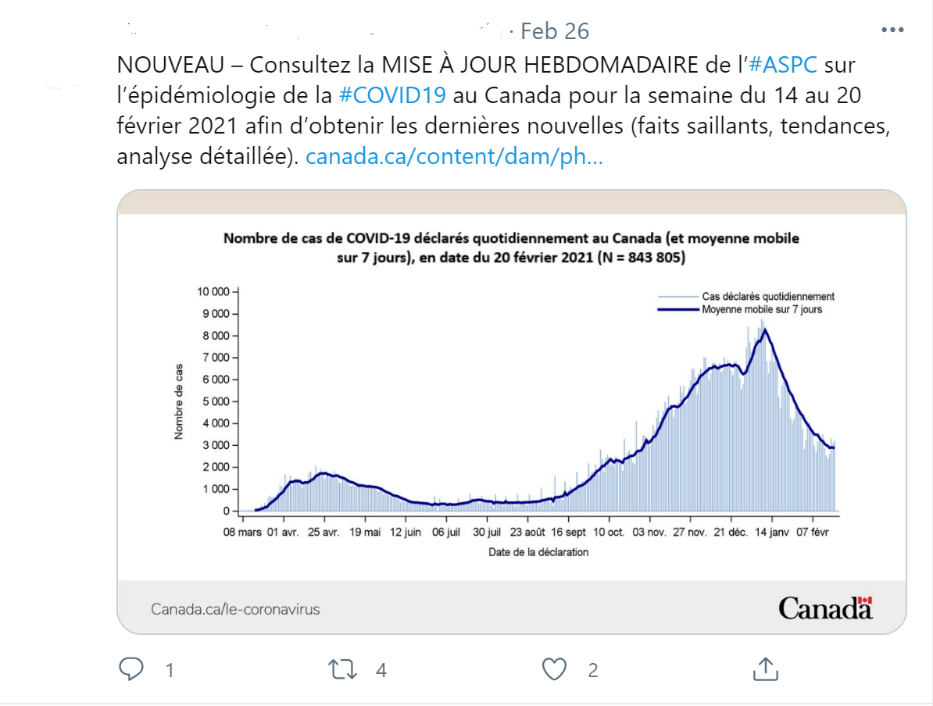
The above figure depicts a Twitter post, with the date of February 26 at the top of the figure. To the right of the date, there are three grey dots. Below the date, grey text reads ‘NOUVEAU – Consultez la MISE À JOUR HEBDOMADAIRE de l’#ASPC sur l’épidémiologie de la #COVID19 au Canada pour la semaine du 14 au 20 février 2021 afin d’obtenir les dernières nouvelles (faits saillants, tendances, analyse détaillée). Canada.ca/content/dam/ph…’ with the link and hashtag words in blue. Below, there is a graph titled ‘Nombre de cas de COVID-19 déclares quotidiennement au Canada (et moyenne mobile sur 7 jours), en date du 20 février 2021 (N = 843 805).’ The X axis depicts ‘Date de la déclaration’ and the Y axis depicts ‘Nombre de cas’. The graph includes light blue vertical lines that represent ‘Cas declares quotidiennement’ and a navy blue trendline that depicts ‘Moyenne mobile sur 7 jours’. The graph peaks on the right hand side. At the bottom of the image, there is the Government of Canada wordmark on the right and Canada.ca/le-coronavirus on the left. Below, in grey, are options to reply, retweet, like and share the figure.
Option A3 (GTA Experiencing COVID Fatigue and Riskier Behaviours)
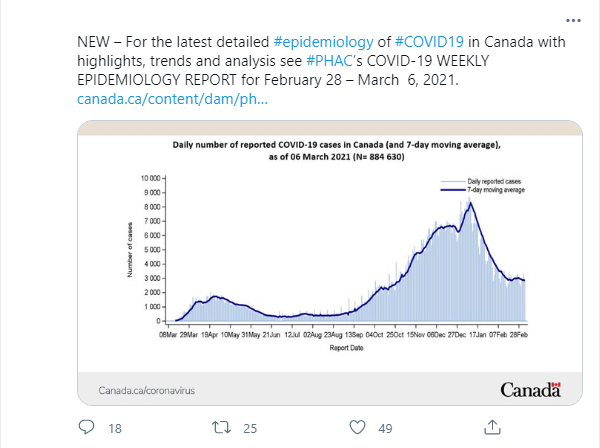
The above figure depicts a Twitter post. In the top right of the image, there are three grey dots. Below, grey text reads ‘NEW – For the latest detailed #epidemiology of #COVID19 in Canada with highlights, trends and analysis see #PHAC’s COVID-19 WEEKLY EPIDEMIOLOGY REPORT for February 28 – March 6 2021. Canada.ca/content/dam/ph…’ with the link and hashtag words in blue. Below, there is a graph titled ‘Daily number of reported COVID-19 cases (and 7-day moving average), as of 06 March 2021 (N= 884 630).’ The X axis depicts a report date and the Y axis depicts number of cases. The graph includes light blue vertical lines that represent the daily reported cases and a navy blue trendline that depicts the 7-day moving average. The graph peaks on the right hand side. At the bottom of the image, there is the Government of Canada wordmark on the right and Canada.ca/coronavirus on the left. Below, in grey, are options to reply, retweet, like and share the figure.
Option B1 (Lower Mainland B.C. Vaccine Hesitant, Major Centres Ontario Opinion Leaders)
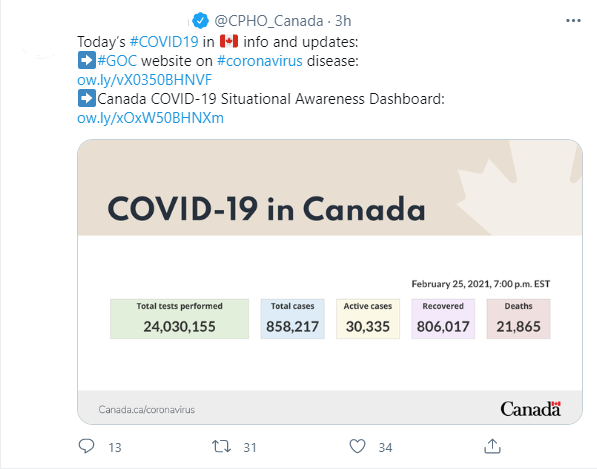
The above figure depicts a Twitter post, posted by @CPHO_Canada, with a blue verification checkmark to the left, and a ‘3h’ to the right in grey font, indicating the tweet had been posted for three hours. To the very right of the Twitter handle, there are three grey dots. Below, text reads ‘Today’s #COVID19 in [Canadian flag emoji] info and updates; [right pointing white arrow in a blue box emoji] #GOC website on #coronavirus disease: ow.ly/vX0350BHNVF [right pointing white arrow in a blue box emoji] Canada COVID-19 Situational Awareness Dashboard: ow.ly/xOxW50BHNXm’ with the hashtags and website links in blue font and the other text in grey font. Below this text, there is a tan backdrop with a lighter maple leaf on the right hand side and ‘COVID-19 in Canada’ in bold black font to the left. Below, there is a white backdrop, with text depicting it was last updated at February 25, 2021, 7:00 p.m. EST. Below this date, there is a green box with text reading ‘Total tests performed 24,030,155’ a blue box with text reading ‘total cases 858,217’ a yellow box with text reading ‘Active cases 30,335’ a purple box with text reading ‘Recovered 806,017’ with a final pink box reading ‘Deaths 21,865.’ At the bottom of the image, there is a light grey bar with the Government of Canada wordmark on the right and Canada.ca/coronavirus on the left. Below, in grey, are options to reply, retweet, like and share the figure.
Option B2 (GTA Experiencing COVID Fatigue and Riskier Behaviours)
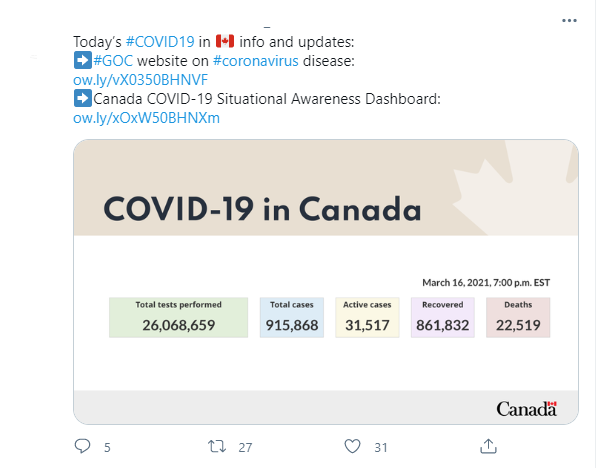
The above figure depicts a Twitter post. In the top right corner of the image, there are three grey dots. Below and to the left, text reads ‘Today’s #COVID19 in [Canadian flag emoji] info and updates; [right pointing white arrow in a blue box emoji] #GOC website on #coronavirus disease: ow.ly/vX0350BHNVF [right pointing white arrow in a blue box emoji] Canada COVID-19 Situational Awareness Dashboard: ow.ly/xOxW50BHNXm’ with the hashtags and website links in blue font and the other text in grey font. Below this text, there is a tan backdrop with a lighter maple leaf on the right hand side and ‘COVID-19 in Canada’ in bold black font to the left. Below, there is a white backdrop, with text depicting it was last updated at March 16, 2021, 7:00 p.m. EST. Below this date, there is a green box with text reading ‘Total tests performed 26,068,659’ a blue box with text reading ‘total cases 915,868’ a yellow box with text reading ‘Active cases 31,517’ a purple box with text reading ‘Recovered 861,832’ with a final pink box reading ‘Deaths 22,519.’ At the bottom of the image, there is a light grey bar with the Government of Canada wordmark on the right. Below, in grey, are options to reply, retweet, like and share the figure.
Option C (Mid-size and Major Centres Quebec Vaccine Hesitant)
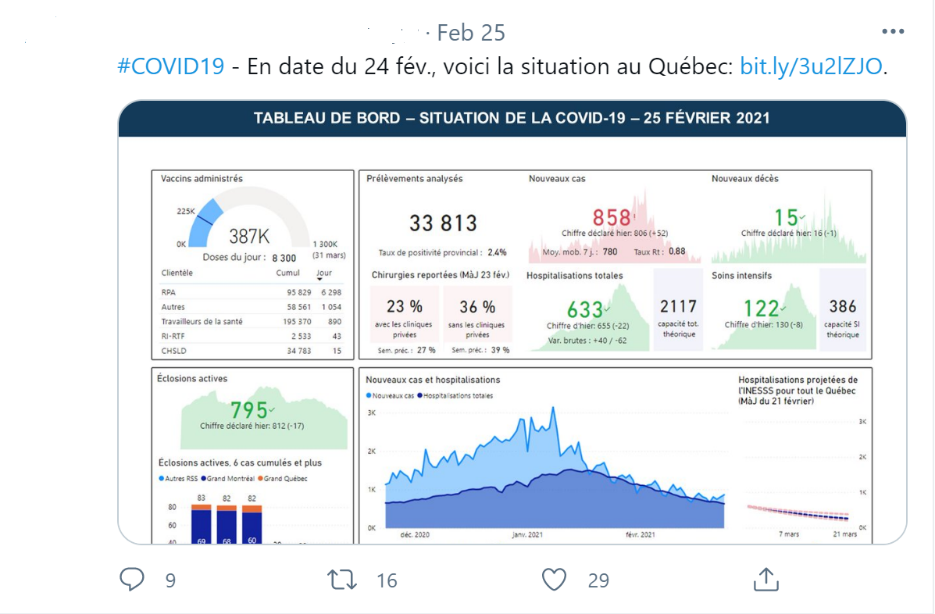
The above figure depicts a Twitter post, with the date of February 25 at the top of the figure. To the right of the date, there are three grey dots. Below the date, grey text reads ‘#COVID19 – En date du 24 fév., voici la situation au Québec: bit.ly/3u2lZJO’ with the link and hashtag words in blue. Below, there is an image with a blue banner and white text reading ‘TABLEAU DE BORD – SITUATION DE LA COVID-19 – 25 FEVRIER 2021.’ Beneath the banner and against a white backdrop there are four boxes. The top left box notes ‘vaccins administres’ where a blue semi-circle graph is showing that 387K doses have been administered. The bottom box on the left-hand side depicts ‘Éclosions actives’ where a green chart features ‘795 Chiffre déclaré hier : 812(-17).’ The box on the bottom right depicts ‘Nouveaux cas et hospitalisations’ where a light blue graph represents ‘nouveaux cas’ and a dark blue graph represents ‘hospitalisations totales.’ The top right box features various statistics and green and red graphs. In order, from the top left hand statistic, in a clockwise direction, the statistics read ‘Prélèvements analyses 33 813’ ‘Nouveaux cas 858’ ‘Nouveaux décès 15’ ‘Soins intensifs 122’ ‘Hospitalisations totales 633’ ‘Chirurgies reportées (MaJ 23 fév.) 23% 36%.’ Below, in grey, are options to reply, retweet, like and share the figure.
Option D (Mid-size and Major Centres Quebec Vaccine Hesitant)
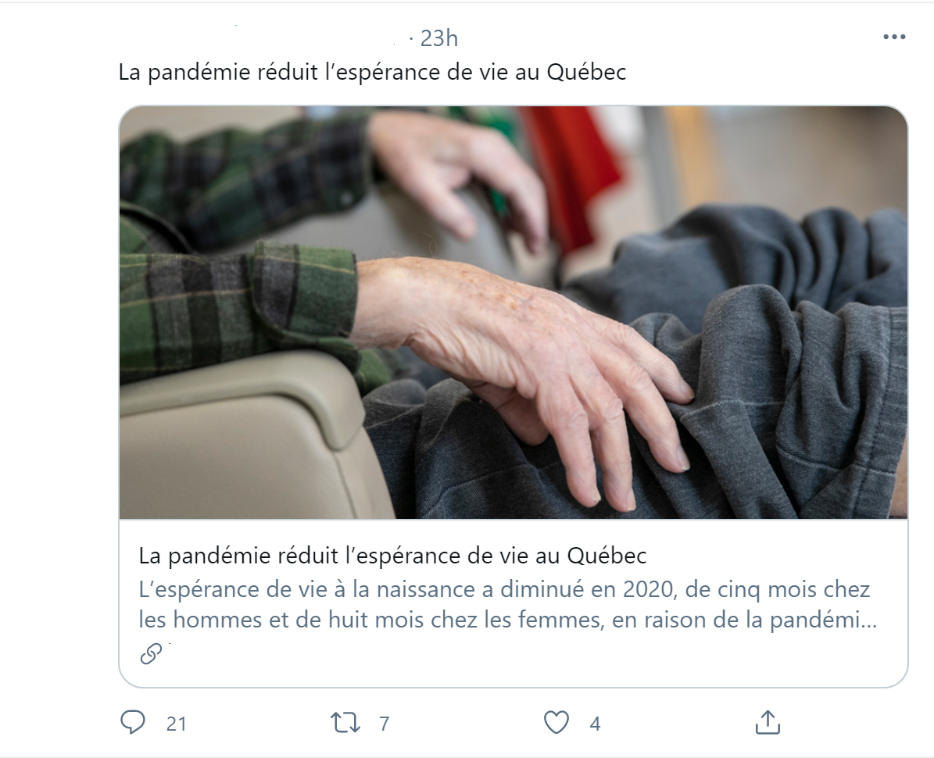
The above figure depicts a Twitter post, with a timestamp of 23h at the top of the figure, indicating the Tweet was posted 23 hours ago. To the right of the date, there are three grey dots. Below the timestamp, a title in black font reads ‘La pandémie réduit l’espérance de vie au Québec.’ Below, there is a close-up picture of an elderly man’s hands while he is sitting in a chair. Below the image, a subtitle in black font reads ‘La pandémie réduit l’espérance de vie au Québec’ with a further description below in grey font reading ‘L’espérance de vie à la naissance a diminué en 2020, de cinq mois chez les hommes et de mois chez les femmes, en raison de la pandémi...’ Below, in grey, are options to reply, retweet, like and share the figure.
Option E (GTA Experiencing COVID Fatigue and Riskier Behaviours)

The above figure depicts a Twitter post. In the top right-hand corner, there are three grey dots. Below and to the left, a title in bold, black font reads ‘Numbers from the science table show new variants spreading rapidly in the province.’ Below, text in normal, black font, text reads ‘The variants are ‘essentially out of control’, said Anthony Dale, CEO of @OntHospitalAssn. It seems pretty self-evident that we’re in the early stages of the third wave.’ Where the words ‘The variants,’ ‘in the’ and ‘the’ are bolded. Below, there is an image of microscopic viral particles emerging from the surface of cells. Below the image, a subtitle in black font reads ‘Coronavirus tracker: How many COVID-19 cases there in Canada a…’ with a further description below in grey font reading ‘COVID-19’s rapid spread has put public-health agencies under pressure to save lives. Check back for daily updates on how the numbers are …’ Below, in grey, are options to reply, retweet, like and share the figure.
Option F (Mid-size and Major Centres Quebec Vaccine Hesitant)

The above figure depicts a Twitter post, with a timestamp of 18h at the top of the figure, indicating the Tweet was posted 18 hours ago. To the right of the date, there are three grey dots. Below the date, a title in black font reads ‘COVID-19 : Montréal se prépare à une augmentation des lies aux variants.’ Below, there is a picture of a woman speaking. Below the image, a subtitle in black font reads ‘COVID-19 : Montréal se prépare a une augmentation des cas lies aux v…’ with a further description below in grey font reading ‘De 15 à 16 % des nouveaux cas de COVID-19 à Montréal sont lies a un variant, selon la sante publique.’ Below, in grey, are options to reply, retweet, like and share the figure.
Option G (Lower Mainland B.C. Vaccine Hesitant, Major Centres Ontario Opinion Leaders)

The above figure depicts a Twitter post, with the date of February 24 at the top of the figure. To the right of the date, there are three grey dots. Below the date, a title in black font reads ‘The problem for Canada will be finding this variant, experts say.’ Below, there is a picture of a multi-colour pathogen against a black background. Below the image, a subtitle in black font reads ‘’Minefield’ of variants: How the California strain is different from the ot…’ with a further description below in grey font reading ‘The latest iteration of COVID-19 making waves is one first identified in California. The Western state is now teeming with the variant…’ Below, in grey, are options to reply, retweet, like and share the figure.
Option H1 (Lower Mainland B.C. Vaccine Hesitant, Major Centres Ontario Opinion Leaders)

The above figure depicts a Twitter post, with the date of February 18 at the top of the figure. To the right of the date, there are three grey dots. Below the date, grey text reads ‘Today, we hit an important milestone: more than 500,000 doses of COVID-19 vaccines administered in Ontario. Thank you to all the health care and frontline workers who made this milestone possible.’ Below this text, there is an image with a dark blue background and features the sketch of a vaccine syringe and clip art viruses. Below, white text reads ‘Ontario has now administered over 500,000 COVID-19 vaccine doses’ with the number 500,000 in bold and the Ontario government wordmark in the bottom right. At the bottom of the figure in grey are options to reply, retweet, like and share the figure.
Option H2 (Mid-size and Major Centres Quebec Vaccine Hesitant)

The above figure depicts a Twitter post, with the date of February 18 at the top of the figure. To the right of the date, there are three grey dots. Below the date, grey text reads ‘a maintenant administre +500 000 doses de vaccins contre la #COVID19. Malgré des retards et des livraisons réduites, la vaccination de nos plus vulnérables progresse. Avec la réception d’autres vaccins, plus de groups pourront être vaccines.’ Below this text, there is an image with a dark blue background and features the sketch of a vaccine syringe and clip art viruses. Below, white text reads ‘Le Quebec a maintenant administré plus de 500 000 doses de vaccins contre la COVID-19’ with the number 500,000 in bold. At the bottom of the figure in grey are options to reply, retweet, like and share the figure.
Option H3 (GTA Experiencing COVID Fatigue and Riskier Behaviours)
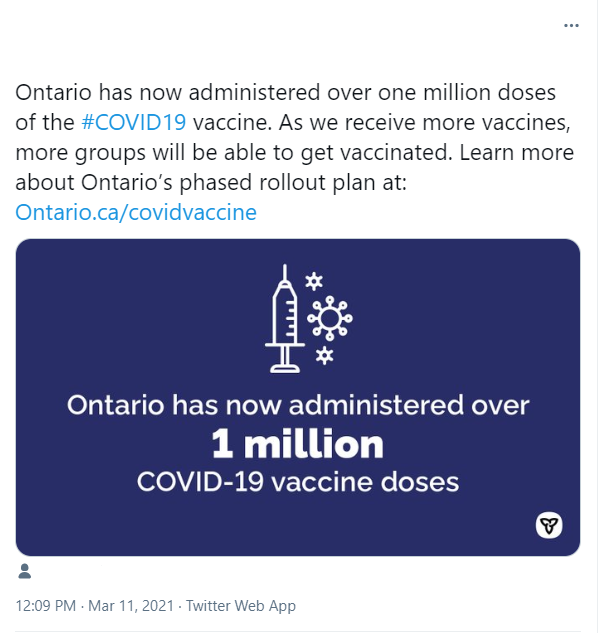
The above figure depicts a Twitter post, with three grey dots in the top right-hand corner. Below, grey text reads ‘Ontario has now administered over one million doses of the #COVID19 vaccine. As we receive more vaccines, more groups will be able to get vaccinated. Learn more about Ontario’s phased rollout plan at: Ontario.ca/covidvaccine.’ Below this text, there is an image with a dark blue background and features the sketch of a vaccine syringe and clip art viruses. Below, white text reads ‘Ontario has now administered over 1 million COVID-19 vaccine doses’ with the number 1 million in bold and the Ontario government wordmark in the bottom right. At the bottom of the figure grey text reads ’12:09 PM. Mar 11, 2021. Twitter Web App.’
Option I (Lower Mainland B.C. Vaccine Hesitant, Major Centres Ontario Opinion Leaders)

The above figure depicts a Twitter post, with the date of February 24 at the top of the figure. To the right of the date, there is three grey dots. Below the date, grey text reads ‘An incredible milestone – over 509580 vaccines administered’ with a party popper emoji. The numbers depicted in the sentence were also emoji’s (white numbers inside blue boxes). The text then continues and reads ‘Protecting mums, dads, grannies, grandpas, loved ones and friends – all thanks to our health care heroes!’ with an emoji of two figures hugging. More text then reads ‘We can achieve so much when we work together.’ With an emoji of two shaking hands. Below, in blue font, text reads ‘#niinjections’ with an emoji of a syringe. Below all this text, there is a picture split by a diagonal line. To the right, there is a photo of a scene depicting a road leading into a tunnel. On the left, there is a navy blue background with the number 509,580 in large yellow font. Below, white font reads ‘reasons to celebrate.’ Below, there is the Uniting UK logo and a light blue vaccine bottle image. At the bottom of the figure in grey are options to reply, retweet, like and share the figure.
Option J (Lower Mainland B.C. Vaccine Hesitant, Major Centres Ontario Opinion Leaders)
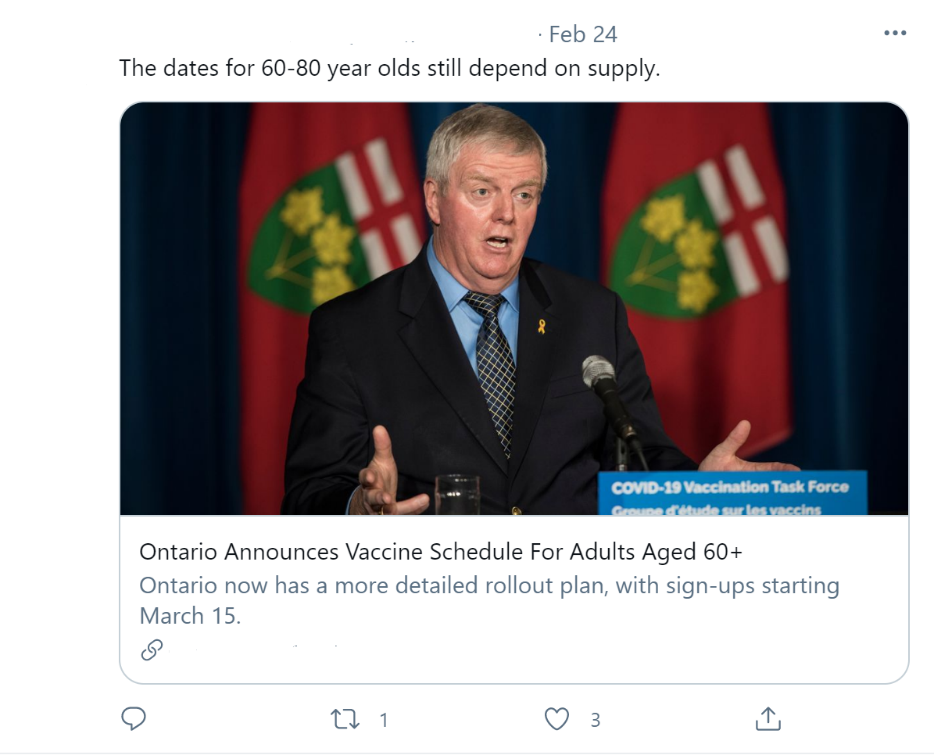
The above figure depicts a Twitter post, with the date of February 24 at the top of the figure. To the right of the date, there is three grey dots. Below the date, grey text reads ‘The dates for 60-80 year olds still depend on supply.’ Below this text, there is a photo of a man giving a speech. Below, black text reads ‘Ontario Announces Vaccine Schedule For Adults Aged 60+’ and below, grey text reads ‘Ontario now has a more detailed rollout plan, with sign-ups starting March 15.’ Below, in grey, are options to reply, retweet, like and share the figure.
Option K (Mid-size and Major Centres Quebec Vaccine Hesitant)

The above figure depicts a Twitter post, with the date of Mar 2 at the top of the figure. To the right of the date, there are three grey dots. Below the date, a title in black font reads ‘COVID-19: Québec recrute 500 nouveaux vaccinateurs en moins d’une semaine | JDQ.’ Below, there is a picture of a vaccination clinic with a red sign in the window reading ‘vaccination’ and clip art of a syringe and a vaccine bottle. Below the image, a subtitle in black font reads ‘Québec recrute 500 nouveaux vaccinateurs’ with a further description below in grey font reading ‘Quelque 500 professionnels de la sante ont répondu à l’appel de Québec à venir prêter main-forte à la champagne de vaccination.’ Below, in grey, are options to reply, retweet, like and share the figure.
Option L (GTA Experiencing COVID Fatigue and Riskier Behaviours)
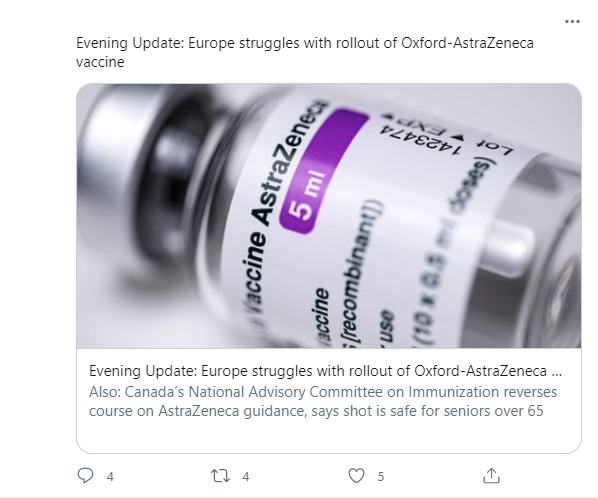
The above figure depicts a Twitter post. In the top right-hand corner, there are three grey dots. Below and to the left, a title in black font reads ‘Evening Update: Europe struggles with rollout of Oxford-AstraZeneca vaccine.’ Below, there is a picture of an AstraZeneca vaccine vial. Below the image, a subtitle in black font reads ‘Evening Update: Europe struggles with rollout of Oxford-AstraZeneca …’ with a further description below in grey font reading ‘Also: Canada’s National Advisory Committee on Immunization reverses course on AstraZeneca guidance, says shot is safe for seniors over 65.’ Below the image, in grey, are options to reply, retweet, like and share the figure.
Option M (GTA Experiencing COVID Fatigue and Riskier Behaviours)

The above figure depicts a Twitter post. In the top right-hand corner, there are three grey dots. Below and to the left, a title in grey font reads ‘Toronto #COVID19 vaccination update for March 16: 282,037 vaccine doses have been administered. For all the info on vaccines in Toronto, go to: Toronto.ca/home/covid-19/….’ Where the hashtag and link are in blue font. Below, there is an image with yellow, pink and light blue stripes at the top, a dark blue background in the middle with white text reading ‘282,037 Total COVID-19 vaccine doses given March 16, 2021’ where the number 282,037 in larger font the other text. There is also a pink band aid image in a circle to the right. Below, there is a slightly lighter blue strip with the City of Toronto wordmark in the bottom right. Below the image, in grey, are options to reply, retweet, like and share the figure.
COVID Alert App QR Code Poster Testing (GMA Young Adults)
Poster 1

The figure above has the Government of Canada wordmark and Government of Canada signature at the top of the image. Below, there is an orange banner, with the COVID Alert App icon on the left with large black text to the right reading ‘Scan here.’ Below, in slightly smaller black font, is text that reads ‘Be notified of possible exposures.’ Below this text and orange banner, there is a backdrop of alternating orange and white diagonal stripes. In the middle of this matter against a white backdrop, there is a QR code. Below the QR code, there is black font reading ‘Tim Hortons 525 Somerset St W, Ottawa, Ontario K1R5W6’. To the right of the QR code, there are three icons in a vertical row with black text to the left. The top icon shows an animated phone with the COVID Alert App icon with ‘Open the COVID Alert app’ text to the right, where the words ‘COVID Alert’ are bolded. The middle icon shows an animated finger pointing at an orange rectangle with the text ‘Tap Scan a place.’ to the right with the words ‘Scan a place’ in bold. The bottom icon depicts an animated phone scanning the poster with the text ‘Point your phone at the QR code’ to the right. Below the alternating orange and white diagonal stripes section, there is an enlarged Orange arrow against a white backdrop on the left with black text inside the arrow reading ‘Download COVID Alert’ with ‘COVID Alert’ in bold. To the right of the arrow are the logos for the Google Play Store and Apple App Store.
Poster 2

The figure above has the Government of Canada wordmark and Government of Canada signature at the top of the image. Below, separated by a black line, is a white banner with the COVID Alert App icon on the left with large black text to the right reading ‘Get notified if a visitor from today tests positive.’ Below this text and white banner, there is a backdrop of alternating orange and white diagonal stripes. In the middle of this matter against a white backdrop, there is a QR code. Below the QR code, there is black font reading ‘Tim Hortons 525 Somerset St W, Ottawa, Ontario K1R 5W6’. To the left of the QR code, there are three icons in a vertical row with black text to the right. The top icon shows an animated phone with the COVID Alert App icon with ‘Open the COVID Alert app’ text to the right, where the words ‘COVID Alert’ are bolded. The middle icon shows an animated finger pointing at an orange rectangle with the text ‘Tap Scan a place.’ to the right with the words ‘Scan a place’ in bold. The bottom icon depicts an animated phone scanning the poster with the text ‘Point your phone at the QR code’ to the right. Below the icons, black text reads ‘Enjoy your visit. Scan again next time.’




